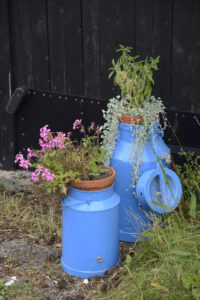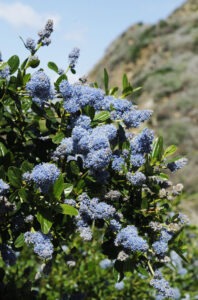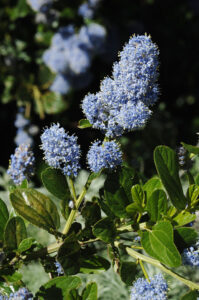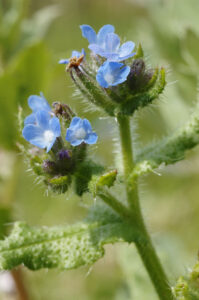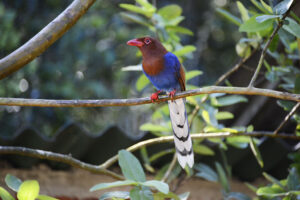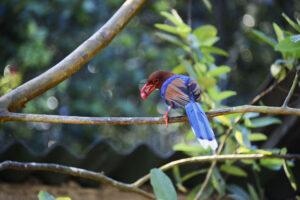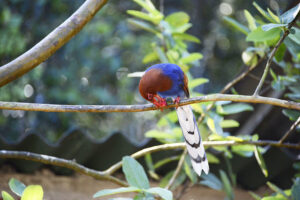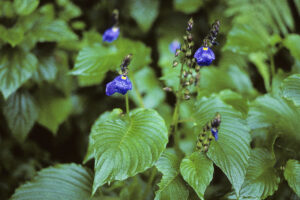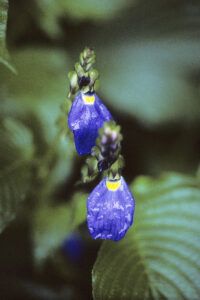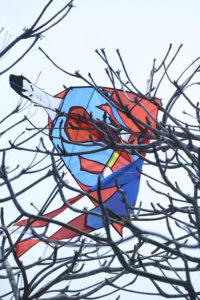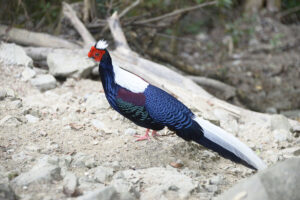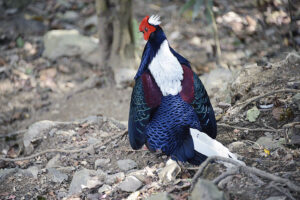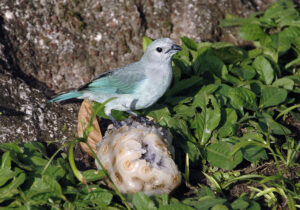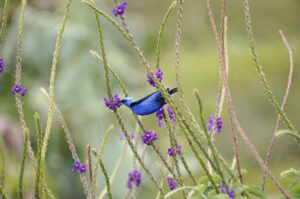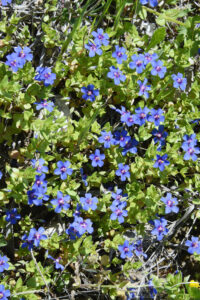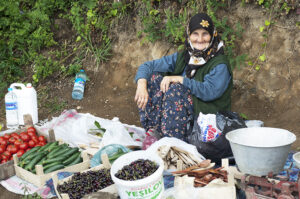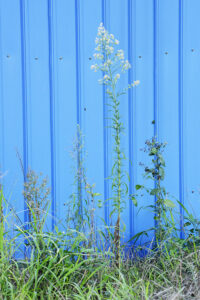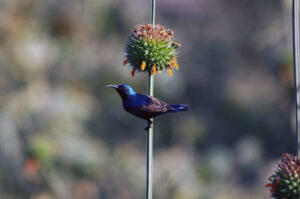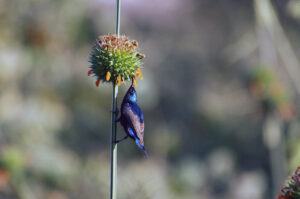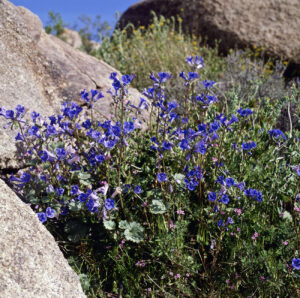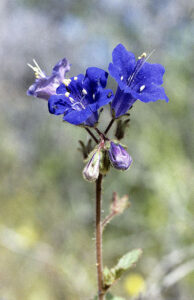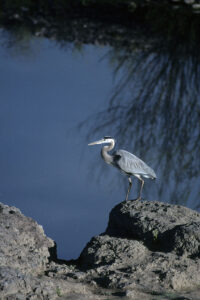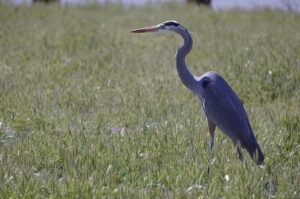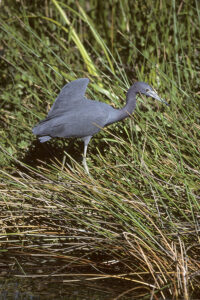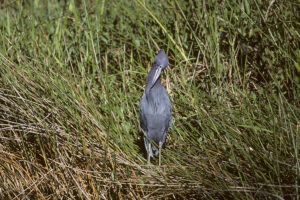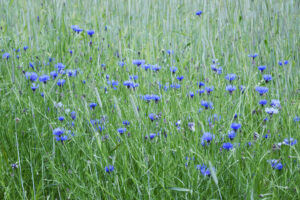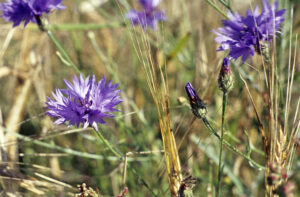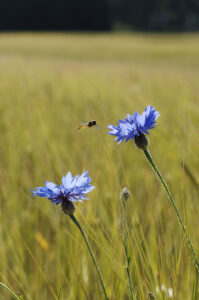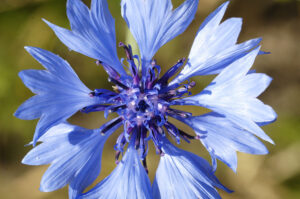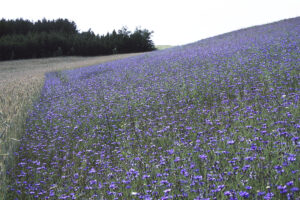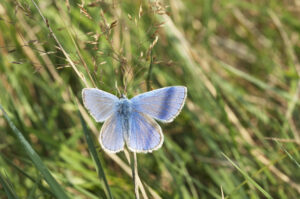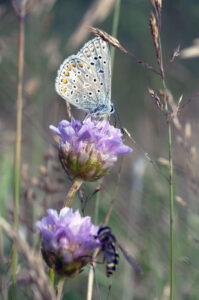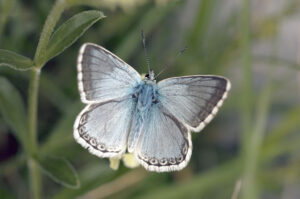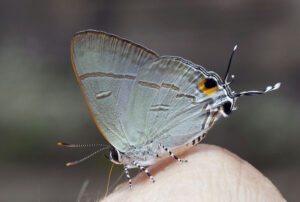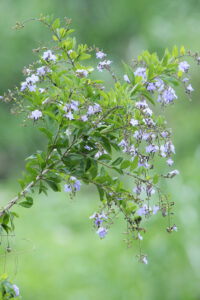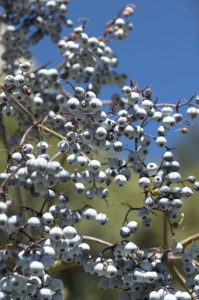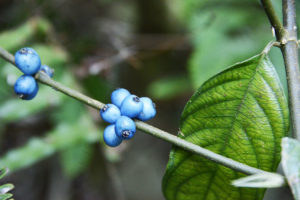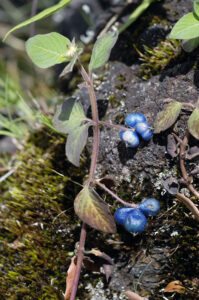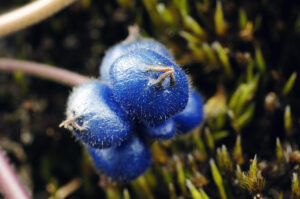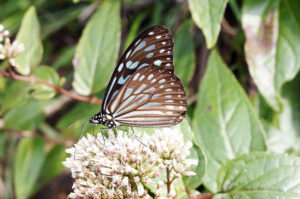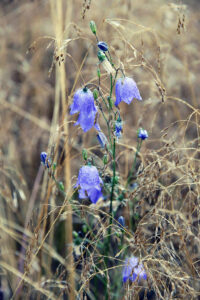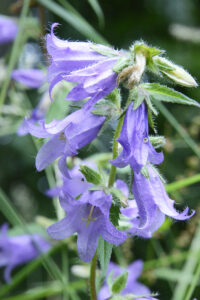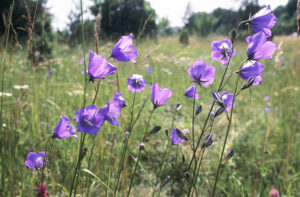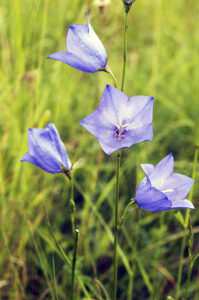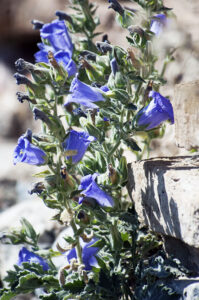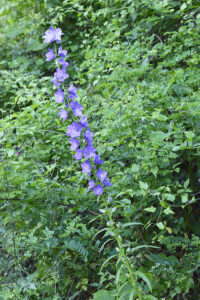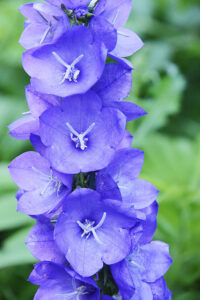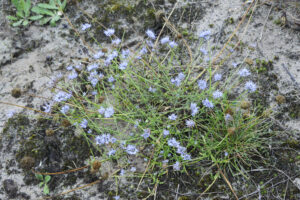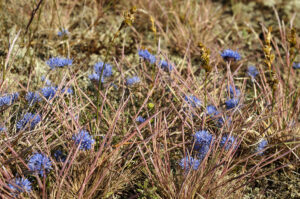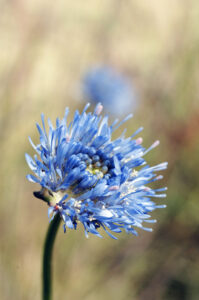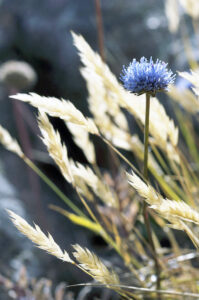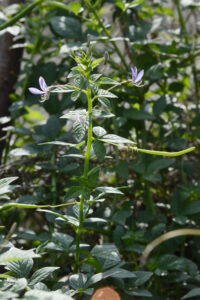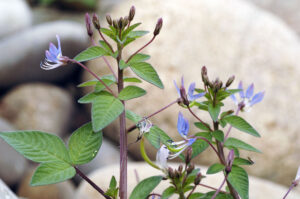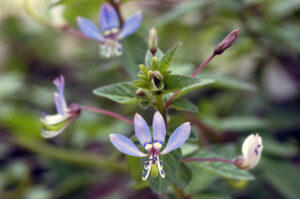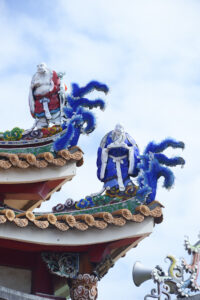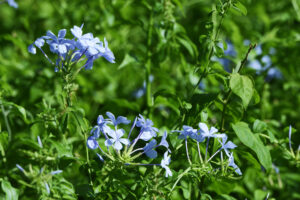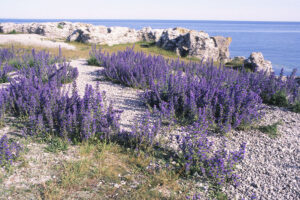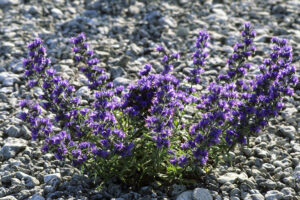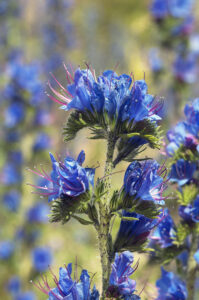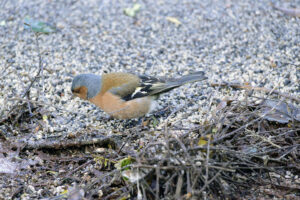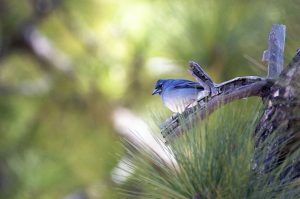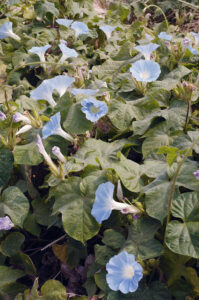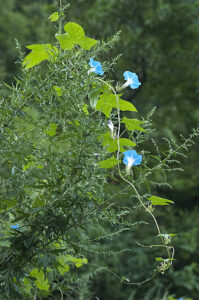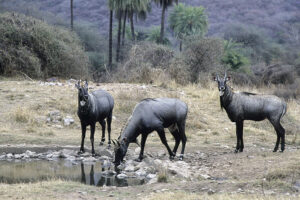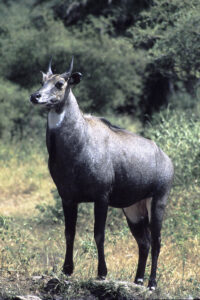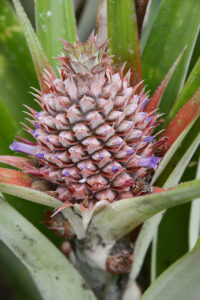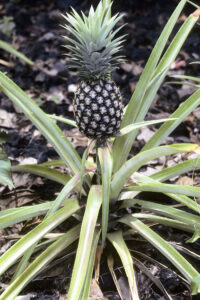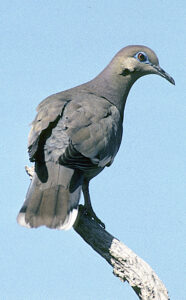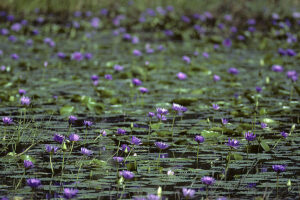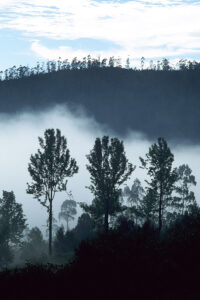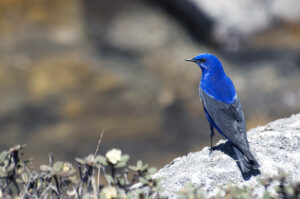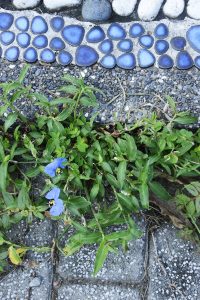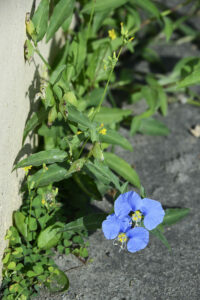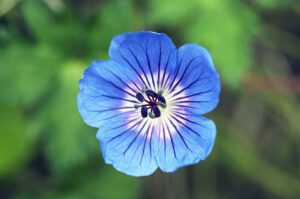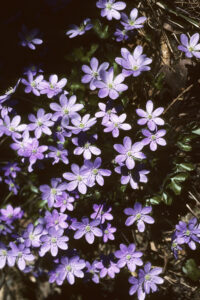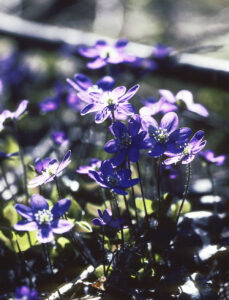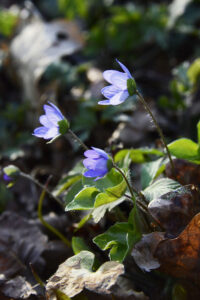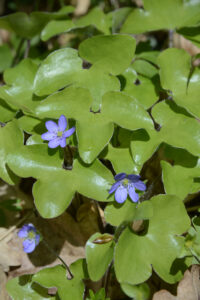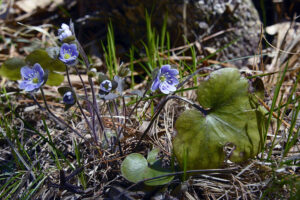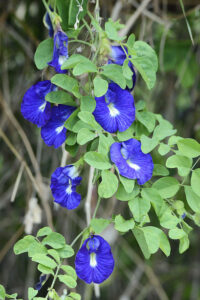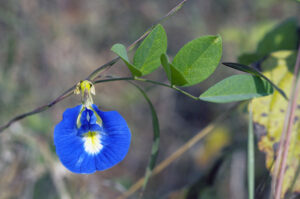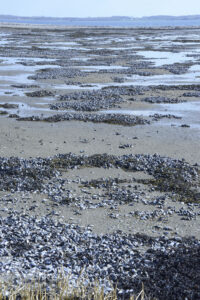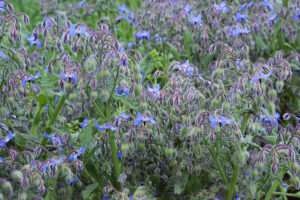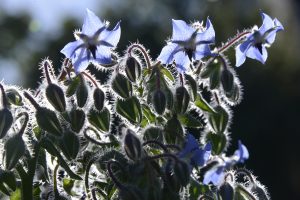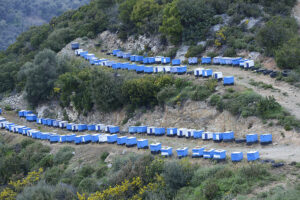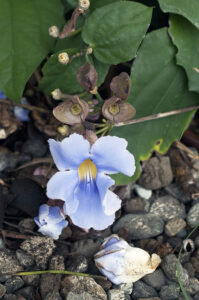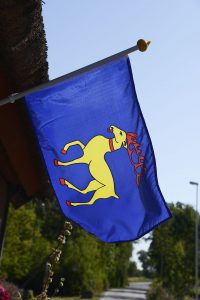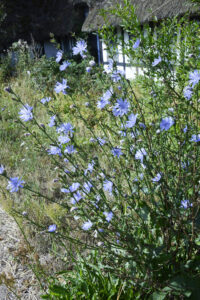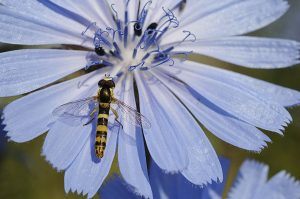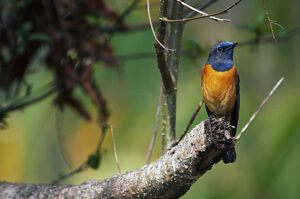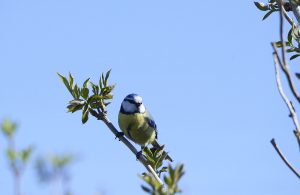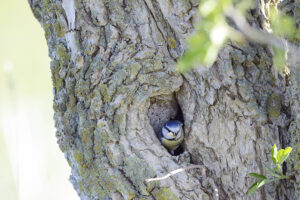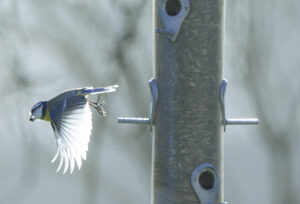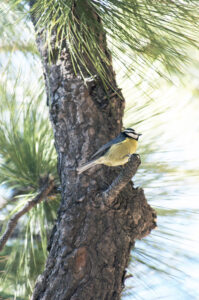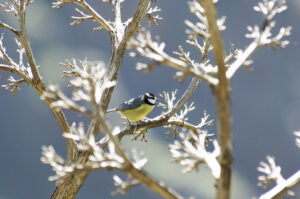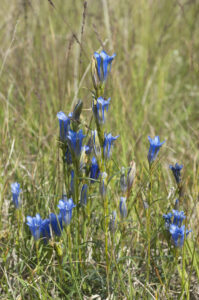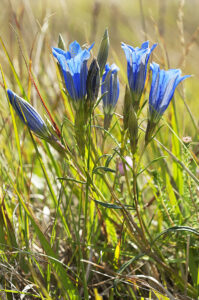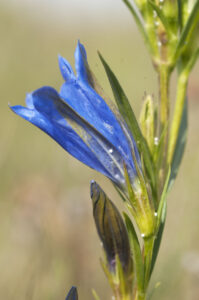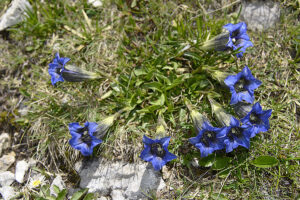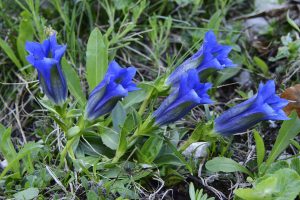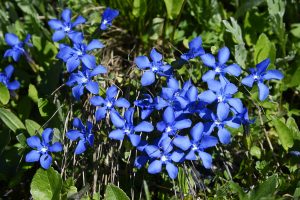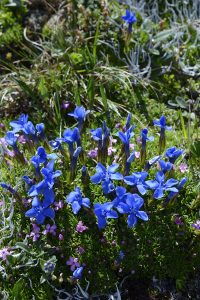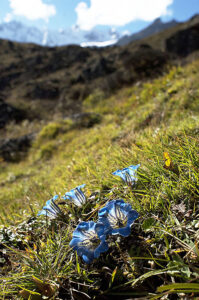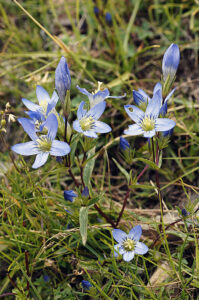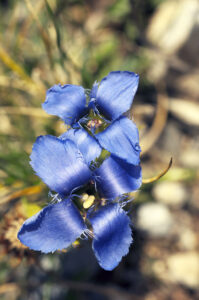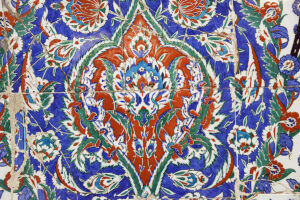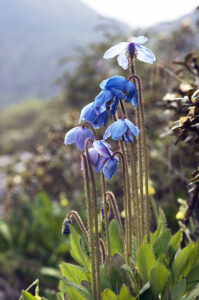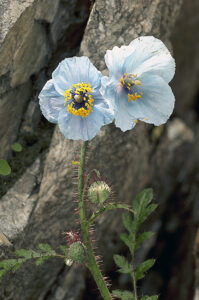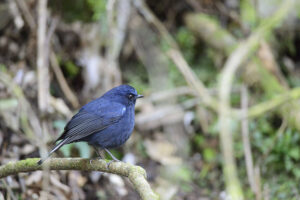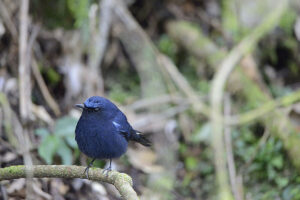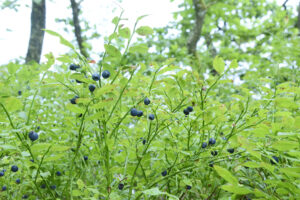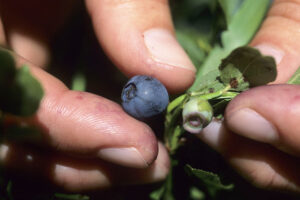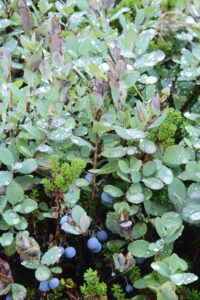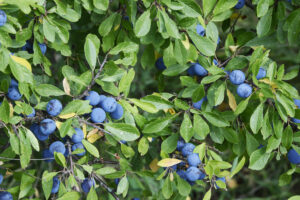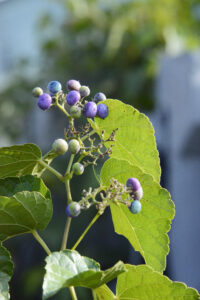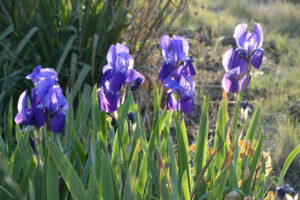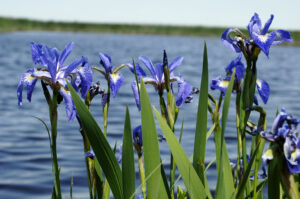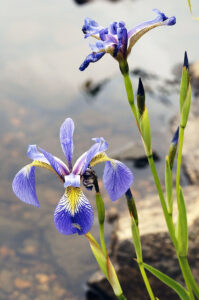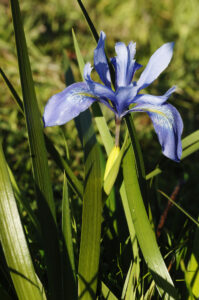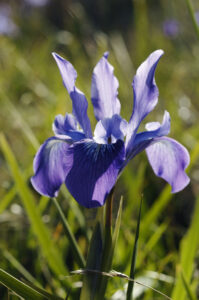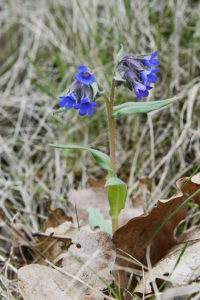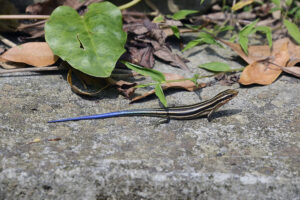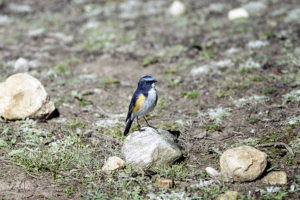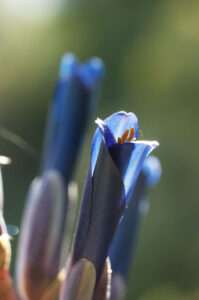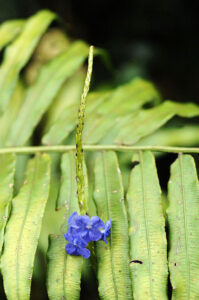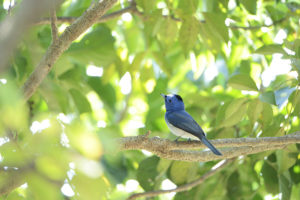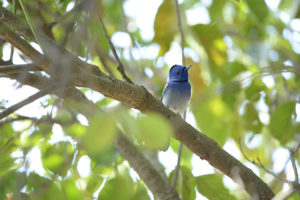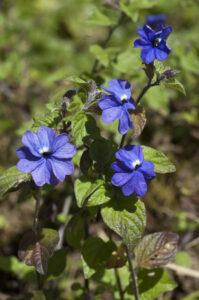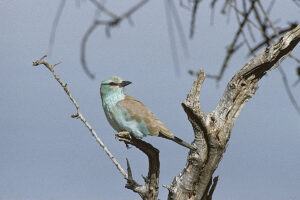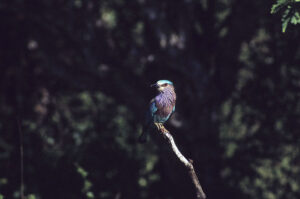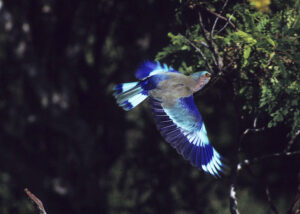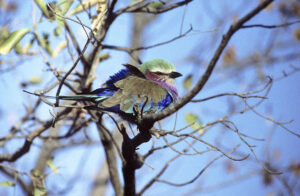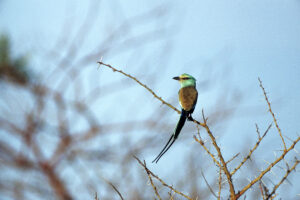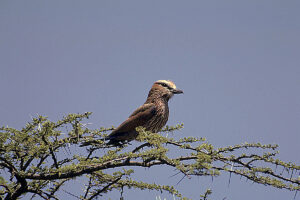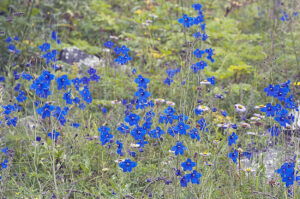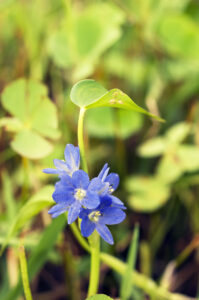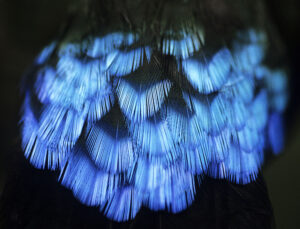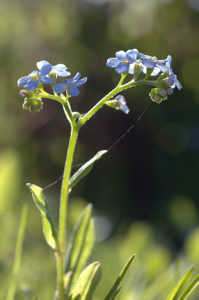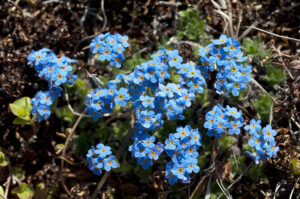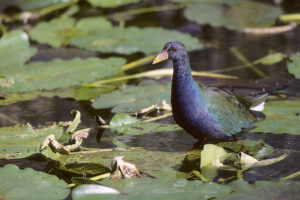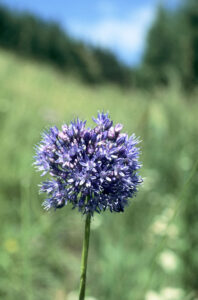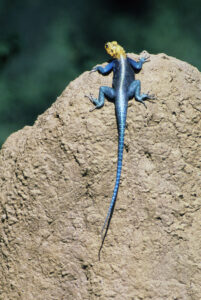In praise of the colour blue
The blue-shorts roller-skating club is out training, Taichung, Taiwan. (Photos copyright © by Kaj Halberg)
Colourful fruits, arranged on a blue cloth by a man, clad in blue, Sultanahmet, Istanbul, Turkey. (Photo copyright © by Kaj Halberg)
In the wonderful Monterey Aquarium in California, huge aquariums, containing various jellyfish, are brightly illuminated, on a blue background. These pictures show purple-striped jellyfish (Chrysaora colorata) (top) and a species of moon jellyfish (Aurelia). (Photos copyright © by Kaj Halberg)
Milk cans, painted blue, act as flowerpots, Hulterstad, Öland, Sweden. (Photo copyright © by Kaj Halberg)
Blueblossom (Ceanothus thyrsiflorus), also known as Californian lilac, is an evergreen tree or shrub, varying dramatically in size, some plants growing to 10 m tall, others less than 1 m. The small flowers, which are arranged in dense clusters at the end of branches, are usually blue, but may also be white or purple. The flowers are much visited by bees and butterflies, and the seed pods are an important food item for birds and small mammals.
Blueblossom, near Salmon Creek, Big Sur, California. (Photos copyright © by Kaj Halberg)
The genus Anchusa, called alkanets, ox-tongue, or bugloss, belongs to the borage family (Boraginaceae). It contains about 38 species, native from Europe and North Africa eastwards to the Ural Mountains, Mongolia, and northern China, and also in Ethiopia and southern Africa.
The generic name is derived from Ancient Greek ankhousa, the name of Alkanna tinctoria, a plant of the same family, which was used as a cosmetic. The name bugloss stems from the Greek bouglosson, the name of Anchusa azurea, from bous (‘ox’) and glossa (‘tongue’), referring to the leaves, which are shaped like an ox-tongue and have a rough surface – just like the tongue of an ox.
The small bugloss (Anchusa arvensis) is a hairy annual with rather narrow leaves and small, pale blue, tubular flowers with a white throat. It probably originates from around the Black Sea or in Central Asia, but was spread to Europe with the arrival of agriculture. Today, it occurs from Scandinavia and Portugal eastwards to the Ural Mountains, the Himalaya, Mongolia, and northern China, and also in Arabia and Ethiopia.
It is a common weed in fields, reflected in the specific name, which means ‘growing in fields’, derived from the Latin arvus (‘cultivated land’). It also occurs along railways and roads, on waste ground, and as a weed in gardens.
Small bugloss, growing at the edge of a field, Jutland, Denmark. (Photo copyright © by Kaj Halberg)
Many houses in the town of Taplejung, eastern Nepal, are painted blue. (Photo copyright © by Kaj Halberg)
During the large annual fair in Sonpur, Bihar, northern India, people act as a clothesline. The thin cloth will dry in a few minutes in the hot sunshine. (Photo copyright © by Kaj Halberg)
As its name implies, the Sri Lanka blue magpie (Urocissa ornata), formerly known as Ceylon magpie, is endemic to Sri Lanka. This gorgeous bird of the crow family (Corvidae) is partial to tall, undisturbed, primary forest in the south-western wet zone of the island, from the lowlands up to an altitude of about 2,100 m.
Occasionally, it will visit secondary forest or other disturbed areas, but is still continuously declining due to loss of suitable habitat. Its food mainly consists of frogs, lizards, insects and other invertebrates, and to some degree fruit.
A large number of members of the crow family are described on the page Animals – Birds: Corvids.
This Sri Lanka blue magpie in Sinharaja Forest Reserve is eating the red outer layer of a palm fruit. (Photos copyright © by Kaj Halberg)
Artwork, exhibited near the Hoan Kiem Lake, Hanoi, Vietnam. (Photos copyright © by Kaj Halberg)
Car wash, Taichung, Taiwan. Bluish and pink soap creates patterns on the car door. (Photo copyright © by Kaj Halberg)
Rhynchoglossum notonianum is a shrubby herb, native to wet evergreen forests of southern India and Sri Lanka. The large leaves, growing to 17 cm long and 11 cm wide, are very characteristic, being highly asymmetric. The small flowers are dark blue, the large lower lip with a yellow spot at the base.
Rhynchoglossum notonianum in rainy weather, Kodaikanal, Tamil Nadu, India. (Photos copyright © by Kaj Halberg)
The fate of many kites! Despite being designed as Superman, this kite ended in a tree. – Taichung Metropolitan Park, Taiwan. (Photo copyright © by Kaj Halberg)
Swinhoe’s pheasant (Lophura swinhoii), also known as Taiwan blue pheasant, is endemic in the mountains of central Taiwan, where it is quite common. It is named after British biologist Robert Swinhoe (1836-1877) who, in 1860, became the first European consular representative to Taiwan. He discovered many new species, and four mammals and 15 birds are named after him.
To lure this gorgeous bird closer, many Taiwanese photographers strew maize or other food near roads or trails, often causing it to become remarkably tame.
Male Swinhoe’s pheasant, Dasyueshan National Forest. (Photos copyright © by Kaj Halberg)
The marvellous Sultan Ahmed Camii (‘Sultan Ahmed Mosque’), in Istanbul, Turkey, is popularly known as ‘The Blue Mosque’. It was constructed between 1609 and 1616, during the rule of Sultan Ahmed I (1590-1617).
Other pictures, depicting this gorgeous building, may be seen on the pages Religion: Islam, and Dawn.
Sultan Ahmet Camii. The flowering tree in the foreground is a horsechestnut (Aesculus hippocastanum). (Photo copyright © by Kaj Halberg)
Fountain in front of Sultan Ahmed Camii. (Photo copyright © by Kaj Halberg)
Blue scaffold, erected during restoration of Sultan Ahmed Camii. (Photo copyright © by Kaj Halberg)
In this picture, taken in Dasyueshan National Forest, Taiwan, a number of bird photographers, all by coincidence clad in blue, are gathered at a tree of the species Idesia polycarpa, whose berries draw birds like a magnet. These berries are shown on the page In praise of the colour red. (Photo copyright © by Kaj Halberg)
Tanagers are a huge American family of passerines, Thraupidae, comprising at least 200 species, of which the majority are found in Mexico, Central America, and South America. Traditionally, about 240 species were included in this family, but, following genetic research, some species have been transferred to the finch family (Fringillidae), others to the cardinal family (Cardinalidae).
The blue-grey tanager (Thraupis episcopus) is common in open woodland, gardens, and cultivated areas, from Mexico through Central America southwards to Bolivia and northern Brazil. It is also found on the Caribbean islands Trinidad and Tobago, and has been introduced to Peru, around the capital Lima.
This blue-grey tanager is feeding on a fallen fruit of great morinda (Morinda citrifolia), Tortuguero National Park, Costa Rica. (Photo copyright © by Kaj Halberg)
The gorgeous red-legged honeycreeper (Cyanerpes cyaneus) is another member of the tanager family, which is distributed from southern Mexico southwards to Peru, Bolivia, and central and eastern Brazil. It is also found on several Caribbean islands, including Trinidad and Tobago, and Cuba.
Male red-legged honeycreeper, feeding in flowers of blue porterweed (Stachytarpheta frantzii), Cordillera de Tilarán, Costa Rica. (Photo copyright © by Kaj Halberg)
The scarlet pimpernel (Lysimachia arvensis, previously known as Anagallis arvensis), of the primrose family (Primulaceae), is probably native to the major part of Europe, northern Africa, and western Asia, but has become naturalized in many areas around the world.
Although called scarlet pimpernel, the flowers of this plant come in a variety of colours, including scarlet, red, flesh-coloured, and bright blue. The blue form is very similar to two other pimpernels, L. foemina and L. monelli. However, it may be identified by the broad, ovate leaves and numerous glandular hairs along the margin of the petals, which has few or no teeth.
The flowers of these plants open only when the sun shines, leading to a number of popular names, including shepherd’s weatherglass. The name pimpernel stems from around 1400, ultimately derived from the Latin piperinella, from piper (‘pepper’), in (‘resembling’), and ella, a diminutive suffix, thus ‘the little one that resembles pepper’. What it refers to is not clear.
Scarlet pimpernel, blue form, Bari, southern Italy. (Photo copyright © by Kaj Halberg)
This elderly woman, clad in blue, has displayed vegetables for sale at the road side, Amasra, northern Turkey. (Photo copyright © by Kaj Halberg)
Horsetail fleabane (Erigeron canadensis) is a composite, described in depth on the page Nature: Invasive species. Other pictures, depicting this species, are shown on the page Plants: Urban plant life.
This horsetail fleabane, about 1.2 m tall, grows along a house wall, consisting of blue metal sheets, Taichung, Taiwan. (Photo copyright © by Kaj Halberg)
Since 1975, the major part of larger elms (Ulmus) in Europe and North America have been killed by Dutch Elm disease, caused by the sac fungus Ophiostoma novo-ulmi (formerly Ceratocystis novo-ulmi), which is spread by elm bark beetles of the genera Scolytus and Hylurgopinus. It is generally believed that the disease originated in Asia, but was accidentally introduced to Europe and North America, where most native elm species had no resistance against the disease.
Dutch Elm disease is described in depth on the page Nature Reserve Vorsø: Dutch Elm disease on Vorsø.
In a silent summer night, these common elms (Ulmus glabra), which have been killed by Dutch elm disease, stretch their dead branches into the bluish sky, Nature Reserve Vorsø, Horsens Fjord, Denmark, (Photo copyright © by Kaj Halberg)
Cinnyris is a genus of sunbirds with about 56 species, widely distributed in Africa and Asia.
The purple sunbird (Cinnyris asiaticus) is common from Oman and southern Iran eastwards across the entire Indian Subcontinent to Southeast Asia. Males may appear all black in bright sunlight, but under good light conditions, at close quarters, the plumage is a brilliant blue-purple iridescence. Females are greenish above and yellowish below.
Male purple sunbird, feeding in flowers of a species of lion’s ear, Leonotis nepetifolia, Bagan, Myanmar. (Photos copyright © by Kaj Halberg)
Phacelia, commonly known as scorpionweed or heliotrope, is a genus of the borage family (Boraginaceae), which was traditionally placed in the waterleaf family (Hydrophyllaceae). However, the latest genetic research has reduced this family to a subfamily, Hydrophylloideae, of the borage family. The genus, comprising about 200 species, is native to the Americas. In California alone, more than 90 species have been encountered.
Desert bells (Phacelia campanularia) is a gorgeous plant, which is restricted to the Mojave and Sonoran Deserts in California. It is commonly cultivated as an ornamental elsewhere and may sometimes escape.
The stem, growing to 70 cm tall, is covered in glandular hairs. The leaves are round in outline, with numerous large teeth along the margin. The bright blue, bell- or funnel-shaped corolla may grow up to 4 cm long, with long, protruding stamens and style.
If the winter has brought ample rain, thousands of these plants will bloom, forming deep-blue masses.
Desert bells, subspecies vasiformis, Joshua Tree National Park, California. (Photos copyright © by Kaj Halberg)
Neither of the two American ‘blue’ herons, the great blue (Ardea herodias) and the little blue (Egretta caerulea), are really blue, but have a bluish tinge to their plumage.
The great blue heron is the largest heron in America – in fact the world’s third-largest heron, only surpassed by goliath heron (A. goliath) and white-bellied heron (A. insignis). It is a common bird, breeding from central Canada southwards to Central America and the Caribbean, with a separate population in the Galápagos Islands. The northernmost populations are migratory, spending the winter as far south as northern South America. Some birds in southern Florida and the Caribbean are pure white, and it is still discussed whether they form a separate species.
The little blue heron is widely distributed in coastal areas in the southern part of North America and along the east coast to Maine, in Central America, and in South America southwards to Peru and southern Brazil. It lives in freshwater as well as brackish water. Northern populations are migratory, wintering in the Caribbean and Central America. After the breeding season, birds may stray northwards to southern Canada, southwards to Uruguay.
Other heron species are described on the pages Fishing, and Animals – Birds: Birds in Africa, Birds in Taiwan, and Birds in the United States and Canada.
Great blue heron, Coon Bluff, Salt River, Arizona. (Photo copyright © by Kaj Halberg)
Great blue heron, feeding on a grassy plain in Ronald W. Caspers Wilderness Park, Santa Ana Mountains, California. (Photo copyright © by Kaj Halberg)
Little blue heron, Everglades National Park, Florida. (Photos copyright © by Kaj Halberg)
In Denmark, the pretty cornflower (Centaurea cyanus) has been encountered in post-glacial layers, but disappeared with the arrival of forests. Later, it re-appeared in the Viking Age, presumably introduced when cereals were brought to the country from the south. It became very common around 1400, when farming of winter crops was introduced, and, together with corn-cockle (Agrostemma githago), it soon became a big problem, as the vigorous growth of these plants inhibits the growth of the crop, thus reducing the yield, in former days often with up to 50%.
Nowadays, following the introduction of chemical herbicides, wild cornflowers are almost exclusively encountered in fields of organic crops, whereas the corn-cockle has gone virtually extinct in northern Europe. Cornflower is sometimes grown for production of seeds.
Today, a sight like this is rare in northern Europe: An abundance of cornflowers in a rye field, Jutland, Denmark. (Photo copyright © by Kaj Halberg)
Cornflower in barley fields, Jutland, Denmark. (Photos copyright © by Kaj Halberg)
Close-up of cornflower, Jutland, Denmark. (Photo copyright © by Kaj Halberg)
Field of cultivated cornflowers, Jutland, Denmark. (Photo copyright © by Kaj Halberg)
Gossamer-winged butterflies (Lycaenidae) is a very large butterfly family with over 4,500 species worldwide, constituting more than 20% of all known butterfly species (excluding moths). Traditionally, the family is divided into a number of subfamilies, of which the blues (Polyommatinae) is the largest.
The common blue (Polyommatus icarus) is probably the commonest species of blue in Europe, although it has been declining in later years. It is found from western Europe and North Africa eastwards across the Middle East, southern Siberia, and Central Asia to northern China. Recently, it has expanded its range to include Canada, where it is rapidly spreading. It may have arrived as a ‘blind passenger’ on board a ship.
Male common blue, sitting on the grass species wavy hair-grass (Avenella flexuosa), Fanø, Denmark. (Photo copyright © by Kaj Halberg)
This male is feeding in thrift flowers (Armeria maritima), Fanø. A hover fly is seen in the foreground. (Photo copyright © by Kaj Halberg)
The chalkhill blue (Lysandra coridon) is widely distributed in Europe, although absent from the northernmost and southernmost areas. It is also found in Asia Minor and in Russia, eastwards to the Ural Mountains.
The popular name alludes to the fact that it mainly occurs in grassy areas, where the soil is rich in chalk.
Male chalkhill blue, St. Martin, Pyrenees, Navarra, Spain. (Photo copyright © by Kaj Halberg)
The common tit (Hypolycaena erylus) is found from the Indian Subcontinent and Southeast Asia southwards through the Indonesian Archipelago to the Philippines and several islands in the western Pacific. It may be identified by the two ‘tails’ on the hindwing, up to 6 mm long.
This common tit, encountered at Ta Prohm, Angkor Wat, Cambodia, is sucking sweat from my finger. (Photo copyright © by Kaj Halberg)
Golden dewdrop (Duranta erecta) is a small shrub of the vervain family (Verbenaceae), native from Mexico and the Caribbean southwards to Paraguay and Argentina. Elsewhere in warmer countries, it is widely cultivated as an ornamental and has become naturalized in many places. It is regarded as an invasive species in a number of countries, including Australia, China, and South Africa, and on several islands in the Pacific.
Other common names of this plant include pigeon berry and Brazilian skyflower, and in Tonga it is known as mavaetangi (‘tears of departure’), alluding to the fruit, which is a small, globose, yellow or orange berry, to 1 cm across. Unripe berries are toxic and are known to have killed children, dogs and cats. Birds, however, are not harmed by the berries. A picture, depicting the berries, is shown on the page In praise of the colour yellow.
The generic name was given in honour of Italian physician, botanist, and poet Gualdo Tadino (1529-1590), better known as Castore Durante da Gualdo.
Golden dewdrop is widely cultivated in Taiwan, in this case in Taichung. (Photo copyright © by Kaj Halberg)
Elders (Sambucus) is a genus of about 27 species of smaller trees, shrubs, or large herbs, distributed mainly in temperate and subtropical areas of the Northern Hemisphere, whereas on the Southern Hemisphere they are restricted to parts of Australia and South America.
Previously, this genus was classified as belonging to the elder family (Sambucaceae), but was then moved to the honeysuckle family (Caprifoliaceae). However, recent DNA analyses have revealed that, in fact, it belongs to the moschatel family (Adoxaceae).
The generic name is from the Greek sambuca, the name of an ancient string instrument of Asian origin. The wood of elder was presumably used in its construction. The name elder is derived from the Anglo-Saxon word aeld (’fire’). In those days, the hollow stems of elder were used to kindle a fire.
Blue elder (Sambucus cerulea), formerly often called Mexican elder (S. mexicana), is a deciduous shrub, which can grow to a height of 9 m. In spring, it displays an abundance of butter-yellow flowers, followed by purplish-blue berries in autumn. It grows up to an altitude of 3,000 m, in a variety of habitats, including river valleys, woodlands, and exposed slopes with access to water. It has a very wide distribution, from British Columbia south through much of western United States to north-western Mexico, with scattered occurrence in Oklahoma and Texas.
Many indigenous tribes used the berries of this plant for food, and a number of herbal medicines were produced from the wood, bark, leaves, flowers, and roots. The wood was also used to make pipes and musical instruments, such as flutes and small whistles. A dye was made from the berries.
Some authorities reduce this species to a subspecies of the widespread common elder (S. nigra), described on the page Plants: Plants in folklore and poetry. Other elder species include red elder (S. racemosa), dealt with on the page Plants: Flora of the Alps and the Pyrenees, and Chinese elder (S. javanica), presented on the page In praise of the colour orange.
Blue elder is named for its whitish-blue berries. These were photographed in Yosemite National Park, Sierra Nevada, California. (Photo copyright © by Kaj Halberg)
The Tuaregs, also known by various other names, including Kel Tamasheq, Imuhagh, Imazighen, and Itargiyen, are a large group of Berber peoples, living in the western half of the Sahara Desert, southwards to Niger, Mali, and Burkina Faso. The Tuaregs have often been called the Blue People, because they dye their clothes with indigo, which stains their skin.
I met this Tuareg south of Arlit, Niger. (Photo copyright © by Kaj Halberg)
Sunglasses for sale, Istanbul, Turkey. (Photo copyright © by Kaj Halberg)
Lasianthus is a genus of about 180 species of tropical and subtropical plants in the bedstraw family (Rubiaceae), varying in size from small shrubs to small trees. They are primarily found in the understory of forests. The core area of the genus is Malaysia and Indonesia with c. 130 species, whereas about 30 species are found in warmer areas elsewhere in Asia, 15 to 20 species in tropical areas of Africa, one in Queensland, Australia, and two in the Neotropics. The fruit is a small drupe, usually blue.
This genus was described by Scottish botanist and physician William Jack (1795-1822), who worked as a surgeon in India, and later in Sumatra, where he died in 1822, presumably of malaria. The generic name is derived from the Greek lasios (‘shaggy’) and anthos (‘flower’), the name given in allusion to the rather shaggy appearance of the flowers of most members of the genus.
Lasianthus fordii is a small shrub, to 2 m tall, which grows in humid, shaded forests at altitudes between 200 and 1,000 m, from southern Japan and China southwards through Southeast Asia and the Philippines to Indonesia and New Guinea.
Fruits of Lasianthus fordii are a gorgeous shade of blue. – Sun-Moon Lake, Taiwan. (Photo copyright © by Kaj Halberg)
Another genus in the bedstraw family with bright blue or purple berries is Coccocypselum, which is native to Central and South America, and the West Indies.
Coccocypselum hirsutum is a creeping herb, distributed from Mexico southwards to Paraguay and southern Brazil. The specific name is derived from the Latin hirtus (‘hairy’ or ‘rough’), alluding to the very hairy appearance of this plant, on stems, leaves, and fruits.
Bright blue fruits of Coccocypselum hirsutum, Parque Nacional Volcán Arenal, Cordillera de Tilarán, Costa Rica. (Photos copyright © by Kaj Halberg)
Members of Danainae, a subfamily of the brush-footed butterfly family (Nymphalidae), are popularly known as monarchs, crows, and tigers. One member is the blue glassy tiger (Ideopsis vulgaris) which is distributed from India eastwards to Taiwan, and thence southwards to Indonesia.
Blue glassy tiger, feeding in flowers of a species of boneset, Eupatorium schimadae, north-eastern Taiwan. (Photo copyright © by Kaj Halberg)
The bellflower genus (Campanula) includes more than 500 species, found in temperate and subtropical areas of the Northern Hemisphere, with the highest diversity around the Mediterranean and in the Middle East.
The generic name, as well as the name of the entire family, Campanulaceae, is due to the bell-shaped flowers of this genus, from the Latin campanula (’little bell’).
Five species are presented below, and several others are described on the pages Plants: Flora of the Alps and the Pyrenees, and Himalayan flora 1.
The widespread harebell (Campanula rotundifolia) has a circumpolar distribution, growing between latitudes 40°N to about 78°N. It is very common in most parts of Europe, where it may be found from the Mediterranean northwards to the Arctic.
The name harebell stems from Scotland, where this species is quite common. Here, it was also known by a number of other names, including bluebell, lady’s thimble, witch’s bells, and witch’s thimble. In the Scottish Highlands, it was widely believed that witches could change into hares at will, and it was regarded as a very bad omen if a hare crossed your way. As the plant was commonly known as witch’s thimble, the name harebell evolved.
In this picture, harebell grows among red fescue (Festuca rubra) in the Hagestad Nature Reserve, Skåne, Sweden. (Photo copyright © by Kaj Halberg)
The nettle-leaved bellflower (Campanula trachelium) is quite common in almost all of Europe, distributed eastwards to western Siberia, southwards to northern Africa and Iran.
Nettle-leaved bellflower, Møns Klint, Denmark. (Foto copyright © by Kaj Halberg)
Peach-leaved bellflower (Campanula persicifolia) is native to the major part of Europe, excluding the British Isles, eastwards to western Siberia, southwards to North Africa, Turkey, the Caucasus, and Kazakhstan. It has also been introduced to the British Isles, Canada, and the United States, where it sometimes becomes naturalized.
In the northern part of its natural range, this species grows down to sea level, whereas in the southern part it is restricted to mountains. It is found in a wide variety of habitats, including grasslands, broad-leaved forest, and along streams. The specific and popular names were given in allusion to its leaves, which to some degree resemble those of peach (Prunus persica).
Peach-leaved bellflower, Lummelunda, Gotland, Sweden. (Photo copyright © by Kaj Halberg)
Peach-leaved bellflower, growing on a coastal bluff, northern Zealand, Denmark. (Photo copyright © by Kaj Halberg)
Campanula tomentosa, also called C. ephesia, is endemic to western Turkey, mainly growing on the Dilek Peninsula, which juts out into the Aegean Sea. It is a densely hairy species, stems several, to 45 cm tall. Basal leaves large, lyrate. Corolla to 3.5 cm long and 3 cm across, bell- or urn-shaped, purple or pale blue, downy outside. It grows on rocks, walls, and ruins, near sea level.
The specific name is Latin, meaning ‘covered in rough hairs’, alluding to the dense hair cover. The alternative name ephesia means ‘from Ephesus’.
Campanula tomentosa, encountered among the ruins of Ephesus, western Turkey. (Photo copyright © by Kaj Halberg)
The gorgeous great bellflower (Campanula grandis), previously known as C. latiloba, is endemic to northern Turkey, restricted to a belt along the Black Sea coast. It is closely related to the widespread peach-leaved bellflower (above), but has a stiff, rather thick, angular stem, to 1 m tall, with a diameter up to 1.5 cm, leaves lanceolate, to 20 cm long, flowers sky-blue, stalkless, to 3 cm across, 2-3 together in each leaf axil, calyx lobes broadly lanceolate or ovate, to 1.2 cm long and 5 mm broad. It is found in a variety of habitats, including meadows, shrubberies, and rocks, from sea level to elevations around 1,200 m.
Great bellflower, Kapisuyu, near Cide, Black Sea, Turkey. (Photos copyright © by Kaj Halberg)
Sheep’s-bit (Jasione montana), which also belongs to the bellflower family, is distributed in Temperate Europe and western Asia. It prefers to grow on rather poor soil, including dunes and heathland.
Sheep’s-bit, Jutland, Denmark. (Photo copyright © by Kaj Halberg)
In this picture, sheep’s-bit grows among tufts of grey hair-grass (Corynephorus canescens), Fanø, Denmark. (Photo copyright © by Kaj Halberg)
On the island of Bornholm, Denmark, sheep’s-bit often grows among coastal rocks, in this case together with sweet vernal grass (Anthoxanthum odoratum). (Photo copyright © by Kaj Halberg)
Water is sprouting out through numerous tiny holes in this sculpture, erected in front of Silkeborg Art Museum, Jutland, Denmark. (Photo copyright © by Kaj Halberg)
I met these Hindu pilgrims, clad in blue, outside the Sri Padmabhasvami Temple in Thiruvananthapuram, Kerala, India. The tika marks on the forehead indicate that they are Vaishnavites, followers of the god Vishnu. (Photo copyright © by Kaj Halberg)
Spider-flowers (Cleome), also known as bee plants, are a genus of about 200 species, distributed in the Americas, Africa, southern Europe, southern Asia, and Australia.
The small-flowered Cleome rutidosperma is native to tropical Africa, but has become naturalized many other places, including southern Asia, Indonesia, and warmer areas of the Americas, and is regarded as an invasive weed in many countries.
Cleome rutidosperma is very common in Taiwan. These were encountered in a drainage canal (top), and in a dry riverbed, both in the city of Taichung. (Photos copyright © by Kaj Halberg)
Images on the roof of the Daoist temple Le Cheng, Taichung, Taiwan. Daoism is described in depth on the page Religion: Daoism in Taiwan. (Photo copyright © by Kaj Halberg)
Blue plumbago (Plumbago auriculata), or blue leadwort, is an evergreen shrub, or sometimes a climber, which may grow to 6 m tall. It is native to eastern South Africa and Mozambique, but is widely cultivated and has become naturalized in many warmer countries around the globe.
The specific name is Latin, meaning ‘eared’, referring to the shape of the leaves. The common name leadwort is more or less a translation of the generic name, which is the Latin word for graphite. It possibly refers to the fact that the root of these plants turn grey when handled.
Blue plumbago, cultivated in a city park, Taichung, Taiwan. (Photo copyright © by Kaj Halberg)
Common viper’s bugloss (Echium vulgare) is native to most of Europe and northern Temperate Asia, and it has also become naturalized in parts of North America. In Swedish, the name of this species is blåeld, meaning ‘blue fire’, alluding to the wonderful blue colour of the flowers, which, when many plants grow together, does resemble ‘blue fire’.
The generic name is derived from Ancient Greek echis, meaning ‘viper’. Greek physician, pharmacologist, and botanist Pedanius Dioscorides (died 90 A.D.), author of De Materia Medica, 5 volumes dealing with herbal medicine, noted the resemblance between the shape of the nutlets and a viper’s head. The long stamens, sticking out of the flower, also resemble a viper’s tongue.
The name bugloss stems from Ancient Greek bouglosson, from bous (‘ox’) and glossa (‘tongue’), referring to the leaves, which are shaped like an ox-tongue and have a rough surface – just like the tongue of an ox.
Formerly, it was believed that these plants could be used as a cure for snake bite. British herbalist Nicholas Culpeper (1616-1654) says: “It is a most gallant herb of the sun; it is a pity it is no more in use than it is. It is an especial remedy against the biting of the viper, and all other venomous beasts, or serpents; as also against poison, or poisonous herbs. Dioscorides and others say that whosoever shall take of the herb or root before they be bitten, they shall not be hurt by the poison of any serpent.”
Common viper’s bugloss, growing abundantly on a gravelly beach on the Swedish island of Gotland. (Photos copyright © by Kaj Halberg)
Common viper’s bugloss, Bornholm, Denmark. (Photo copyright © by Kaj Halberg)
The chaffinch (Fringilla coelebs) breeds all over Europe, with the exception of Iceland and far northern Norway and Russia. It is also found on the Azores, Madeira, and the Canary Islands, in North Africa, Turkey, northern Iran, and western Turkmenistan, and in Russia eastwards to central Siberia. It has also been introduced to New Zealand and South Africa.
The male is a pretty bird, with reddish breast and belly, bluish-grey head and nape, olive-green or brownish back and scapulars, and black wings with two conspicuous white bars. The female is greyish-brown, also with white wing bars. Males of the various subspecies in North Africa and on the Atlantic islands are much more bluish, and some authorities speculate that they might constitute several separate species.
Chaffinches were introduced to New Zealand in the 1860s, and several times later. Today, it is very common all over the country. This male was encountered at Lake Tikitapu. (Photo copyright © by Kaj Halberg)
On the Canary Islands, another species of chaffinch, the aptly named blue chaffinch (Fringilla teydea), lives in pine forests on the island of Tenerife – and nowhere else.
Male blue chaffinch, sitting in a Canary Islands pine (Pinus canariensis), Las Lajas, Teide, Tenerife. (Photo copyright © by Kaj Halberg)
Ipomoea is a huge genus of the morning-glory, or bindweed, family (Convolvulaceae), comprising more than 500 species, most of which are twining plants with large, beautiful flowers.
The generic name, from the Greek ip (‘worm’) and hómoia (‘resembling’), was given by Swedish naturalist Carl Linnaeus (1707-1778) in allusion to the worm-like movements of the stem, twining around other plants, fences, etc.
The blue morning-glory (I. nil), also called ivy morning-glory due to the shape of its leaves, is probably native to Mexico or Central America, but has been introduced to most warmer parts of the world, where it has become naturalized in many places. Flowers of this species are various shades of blue, with a white funnel. It can be told from similar species by the base of its calyx, which is hairy.
Many other members of the morning-glory family are described on the page Plants: Morning-glories and bindweeds.
This picture is from Taiwan, where a pale blue form of blue morning-glory is very common. (Photo copyright © by Kaj Halberg)
Blue morning-glory, entwining a species of mugwort (Artemisia), Lower Marsyangdi Valley, central Nepal. (Photo copyright © by Kaj Halberg)
Blue patterns, painted around a blue door in an abandoned house, Rethymno, Crete. (Photo copyright © by Kaj Halberg)
The nilgai (Boselaphus tragocamelus) is a large, stout antelope, distributed in the major part of India, and also a small population in southern Nepal.
The name nilgai is Hindi, meaning ‘blue cow’, alluding to the slate-coloured, slightly bluish coat of the male, and to its similarity to the sacred cow. For the latter reason, the nilgai is protected by devout Hindus and has thus escaped the fate of many other animals in India, which are on the brink of extinction, including tiger (Panthera tigris), lion (Panthera leo), and blackbuck (Antilope cervicapra). The coat of females and young males is a pale sandy brown. Both sexes have a white throat patch.
The scientific name of this antelope is quite peculiar. It is derived from four Greek words, bous (‘cow’), elaphos (‘deer’), tragos (‘goat’), and kamelos (‘camel’). The name was applied by Prussian naturalist Peter Simon Pallas (1741-1811), to whom this antelope apparently resembled a mixture of these four animals.
Nilgai males, drinking from a waterhole, Sariska National Park, Rajasthan, north-western India. (Photos copyright © by Kaj Halberg)
Pineapple (Ananas comosus), of the family Bromeliaceae, is native to South America, where it has been cultivated for hundreds of years. Today, it is cultivated in warm areas around the world, Hawaii, Costa Rica, Brazil, and the Philippines being the largest producers.
Botanically, the pineapple is an herb, which may grow to 1.5 m tall, sometimes taller. It has a short, stocky stem with tough, waxy, spiny leaves, growing to 1 m long. It produces up to 200 bluish flowers, in cultivation sometimes more. In the wild state, it is pollinated primarily by hummingbirds, sometimes at night by bats. The individual fruits, which are berries, join together to create a multiple fruit, the ‘pineapple’.
The English name stems from 1568, from the book Les singularitez de la France antarctique (1557), written by French priest, explorer, and writer André Thevet (1516-1590), relating his experiences in France Antarctique, a French settlement near present-day Rio de Janeiro. In English, this book is titled The New Found World, or Antarctike. Thevet refers to a fruit, cultivated and eaten by the Tupinambá people, living in this area. He describes the fruit as nanas, a Tupi word meaning ‘excellent fruit’, and says that it was made in the manner of a ‘pine apple’ (pine cone). (Source: en.wikipedia.org/wiki/Pineapple)
The Tupi word was adopted by Scottish botanist Philip Miller (1691-1771) as the plant’s generic name in the form Ananas, whereas the specific name is Latin, derived from coma, which literally means ‘hair’, but is also used as a term for leaves, thus ‘with many leaves’.
Flowering pineapple, Taiwan. (Photo copyright © by Kaj Halberg)
Unripe pineapples are sometimes bluish. This picture is from Grande Comore, Comoro Islands. (Photo copyright © by Kaj Halberg)
In a suburban area in Taichung, Taiwan, a retired soldier has adorned an entire neighbourhood – walls, streets, doors – with colourful paintings. For this reason, the area has been dubbed Tsai Hung Tsun (‘Rainbow Village’). The picture below shows an example of his art. Others are shown on the page Culture: Folk art in Taiwan.
(Photo copyright © by Kaj Halberg)
In flight, the white-winged dove (Zenaida asiatica) is a striking bird, displaying crescent-shaped white wing-patches and black flight-feathers, and it also has a bright blue patch of naked skin around the eye.
Despite its specific name asiatica, meaning ‘from Asia’, this dove is a New World bird, distributed in south-western United States, Mexico, Central America, and the Caribbean. Presumably, Swedish naturalist Carl Linnaeus (1707-1778), who named this bird Columba asiatica in 1758, was told that the type specimen originated in Asia.
The present generic name was introduced in 1838 by French ornithologist Charles Bonaparte (1803-1857), 2nd Prince of Canino and Musignano, in honour of his wife Zénaïde (1801-1854).
White-winged dove, photographed near Tucson, Arizona. (Photo copyright © by Kaj Halberg)
The gorgeous waterlilies (Nymphaea) are a genus of about 50 species, widespread around the world. The generic name is derived from the Greek nymphe (’nymph’). According to legend, a water-living nymph was deeply in love with the powerful hero Heracles (in Latin called Hercules), who, however, did not return her love. She languished and died, and from her body rose the beautiful waterlily.
The blue waterlily (Nymphaea caerulea), often popularly called Nile lotus or sacred blue lily-of-the-Nile, is distributed in most of eastern Africa, from Egypt southwards to South Africa.
An abundance of blue waterlilies cover the surface of a pond near Tanga, northern Tanzania. (Photo copyright © by Kaj Halberg)
The Nilgiri Mountains constitute a part of the Western Ghats, a mountain range, which stretches most of the way along the west coast of India, from Goa southwards to the southern tip of the subcontinent. The highest point in the Nilgiris is Dodabetta (2637 m).
The name Nilgiri is derived from the Tamil neelakurinji, the local name of a blue-flowered plant, Strobilanthes kunthiana, of the acanthus family (Acanthaceae), which only blooms at intervals of 12 years, but so profusely that entire mountain slopes become bluish. (Neela means ‘blue’ in Tamil). By the British, neelakurinji was corrupted to nilgiri, which means ’blue hill’ in Hindi, thus largely the same meaning.
Towards the end of the 1800s, a narrow-gauge railway track was constructed, heading out from the small town of Mettupalayam in the state of Tamil Nadu, leading up through the Nilgiri Mountains and terminating at the hill station Ootacamund (Ooty). This steep railway is operated by a small blue steam train, the Nilgiri Mountain Express.
Over a distance of 46 km, the terrain rises from c. 300 to c. 2,200 m altitude, the tracks passing through 16 tunnels, and across 31 larger and c. 200 smaller bridges. The lower mountain slopes are covered in tropical monsoon forest, and this area is full of waterfalls. Above c. 1,400 m, the forest gives way to plantations of tea, pines, and eucalyptus.
Bluish morning mist envelops a eucalyptus plantation in the Nilgiri Mountains, but, as the text above relates, this is not the reason why these mountains got their name. – Eucalyptus is described on the page Plants: Plants in folklore and poetry. (Photo copyright © by Kaj Halberg)
In this picture, the Nilgiri Mountain Express is puffing its way up into the Nilgiri Mountains. (Photo copyright © by Kaj Halberg)
Passengers have disembarked during a break at a tiny mountain station. (Photo copyright © by Kaj Halberg)
The male grandala (Grandala coelicolor) is a gorgeous bird, whose plumage is an almost iridescent hue of blue, whereas the female is greyish with faint white stripes on head, nape, and breast, and a brownish tinge to the wings.
This species is distributed from Kashmir along the entire Himalayan chain, and thence northwards through eastern Tibet to western China, from northern Yunnan northwards to eastern Qinghai. It breeds at very high altitudes, between 4,000 and 5,500 m, moving to slightly lower elevations in winter.
Classification-wise, this species has been knocked about a great deal. Initially, it was regarded as belonging to the thrush family (Turdidae), but following genetic studies it was then transferred to the flycatcher family (Muscicapidae). However, recently it has been moved back to the thrush family!
From a stone in a mountain stream in the Gokyo Valley, Khumbu, eastern Nepal, this male grandala would alight and flutter about butterfly-like to snap an insect, before returning to its vantage point. (Photo copyright © by Kaj Halberg)
Dayflowers (Commelina) is a genus of anywhere between 100 and 170 species, found in tropical and subtropical regions around the world. These plants are called dayflowers due to their flowers, which usually only live for one day.
When Swedish naturalist Carl Linnaeus (1707-1778) named the genus, he let the two showy blue petals of Commelina communis represent two Dutch botanists, Jan and Caspar Commelijn, whom he wished to honour.
Jan Commelijn (1629-1692), also known as Johannes Commelinus, became a professor of botany, when many plants were imported from the Cape and Ceylon (today Sri Lanka). He also took part in establishing a botanical garden, named Hortus Botanicus. His nephew Caspar Commelijn (1667-1734) became the director of Amsterdam Botanical Garden. (Source: D.O. Wijnands 1983. The Botany of the Commelins. Rotterdam)
Dayflowers have 3 petals, the upper 2 being bright blue or indigo, whereas the much smaller lower petal is white. Each flower has 6 stamens, 3 upper ones with yellow anthers, which are sterile, and 3 lower ones with white or purple anthers, which are fertile.
Asiatic dayflower (Commelina communis) is native to large parts of eastern Asia, from Ussuriland, south-eastern Russia, southwards through China, Korea, Japan, and Taiwan to the northern part of Southeast Asia and extreme eastern India. It has also been introduced to western Russia, south-eastern Europe, and eastern North America, where it has become invasive in several places.
In Chinese traditional medicine, the dried plant is utilized to treat a number of ailments, including sore throat, colds, oedema, bruises, and limited urination. A near relative, Commelina benghalensis, is eaten as a vegetable in Southeast Asia and Africa.
Asiatic dayflower, growing along a street in Taichung, Taiwan, adorned with pebbles, which have been painted blue. (Photo copyright © by Kaj Halberg)
This Asiatic dayflower has sprouted next to a house wall in Taichung. (Photo copyright © by Kaj Halberg)
The city of Jodhpur, Rajasthan, north-western India, was founded in 1459 by Rajput Prince Rao Jodha. The Old Town is aptly called ‘The Blue City’, as most of its houses are painted a light blue. Originally, these blue houses were inhabited by Brahmins, and their colour indicated that here you could ask advice about disease as well as religious issues. Furthermore, the blue paint contains copper oxides, which keep termites at bay.
Blue houses in Jodhpur. (Photos copyright © by Kaj Halberg)
The Himalayan cranesbill (Geranium himalayense) is quite similar to the widespread meadow cranesbill (G. pratense), which also grows in the Himalaya, but as a rule it is a larger plant, with petals up to 3 cm long, versus 2 cm in meadow cranesbill. It is found from Afghanistan eastwards to central Nepal, growing at elevations between 2,100 and 4,400 m.
Many other Geranium species are presented on the page In praise of the colours violet, purple and lilac.
Himalayan cranesbill, Great Himalayan National Park, Himachal Pradesh. (Photo copyright © by Kaj Halberg)
Blue anemones (Hepatica), also called hepatica, liverleaf, or liverwort, were named for their mostly three-lobed leaves, hepatica being derived from the Greek hepar (‘liver’). As the outline of the leaf resembles the human liver, followers of the Doctrine of Signatures claimed that they could be used for treatment of liver disorders. This is not the case, but the plant has been used to treat wounds, as an astringent, and as a diuretic.
This genus of the buttercup family (Ranunculaceae), which is native to Eurasia and eastern North America, has caused much confusion among taxonomists as to the number of species, which varies from 7 to 13, depending on authority. Others treat these plants as members of the genus Anemone, which, together with the genus Pulsatilla, is described in depth on the page Plants: Anemones and pasque flowers.
The genus includes the following species, subspecies, and/or varieties:
Hepatica nobilis var. nobilis (European hepatica, or blue anemone), found from Scandinavia and the Baltic southwards to Italy and the Balkans.
H. pyrenaica = H. nobilis var. pyrenaica (Pyrenean hepatica), distributed in the Pyrenees and northern Spain.
H. transsilvanica (Romanian hepatica), restricted to mountains in Romania.
H. falconeri, found in montane forests of Central Asia.
H. asiatica = H. nobilis var. asiatica, distributed in central and eastern China, Korea, and south-eastern Siberia.
H. henryi, found in central and western China.
H. yamatutai, restricted to Mount Emei Shan, Sichuan Province, China.
H. insularis, occurring in southern Korea.
H. maxima, endemic to Ulleung-do Island, Korea.
H. japonica = H. nobilis var. japonica, found in Japan.
H. pubescens = H. nobilis var. pubescens, occurring in central Honshu, Japan.
H. americana = H. nobilis var. obtusa (round-lobed hepatica), distributed in eastern North America.
H. acutiloba = H. nobilis var. acuta (sharp-lobed hepatica), likewise found in eastern North America.
Some authorities treat these plants, and also the genus Pulsatilla, as members of the genus Anemone. All three groups are dealt with in detail on the page Plants: Anemones and pasque flowers.
Large growth of European hepatica (Hepatica nobilis var. nobilis), Knisa Mosse, Öland, Sweden. (Photos copyright © by Kaj Halberg)
European hepatica (Hepatica nobilis var. nobilis), eastern Jutland, Denmark. The leaves usually appear later than the flowers, but occasionally they may be seen together, as in the bottom picture. (Photos copyright © by Kaj Halberg)
This round-lobed hepatica (Hepatica americana), encountered in Clement Farm Conservation Area, Massachusetts, United States, has just begun blooming. The leaves are from the previous year. (Photo copyright © by Kaj Halberg)
The gorgeous butterfly pea (Clitoria ternatea), also called Asian pigeon-wings or bluebell vine, is a native of the southern Arabian Peninsula and Tropical Asia, and has been widely introduced elsewhere as an ornamental, including Africa, Australia, and America.
It is widely utilized in traditional Ayurvedic medicine for various purposes, including as an anti-depressant, a tranquilizer, and a sedative. In traditional Chinese medicine, it has been used for female diseases due to its similarity to the female reproductive organ – a typical example of the Doctrine of Signatures, whose followers claim that the Great God made all plants, so that humans would recognize the usage of them.
In China, Taiwan, and Southeast Asia, the flowers are used as a natural food colouring.
This plant was first named Lathyrus spectabilis by Swedish naturalist Pehr Forsskål (1732-1763), in Yemen, during the Royal Danish Expedition to Arabia 1761-1767. Later, it was renamed Clitoria ternatea by Forsskål’s mentor, the famous Swedish botanist Carl Linnaeus (1707-1778). Nobody can doubt what he was referring to!
The fascinating, albeit short, life of Pehr Forsskål is related on the page People: Pehr Forsskål – brilliant Swedish scientist.
Butterfly pea, photographed near Kenting, southern Taiwan (top), and near Mysore, Karnataka, South India. (Photos copyright © by Kaj Halberg)
In its widest sense, the blue mussel (Mytilus edulis), of the family Mytilidae, is distributed along coasts in almost all parts of the world. However, it varies quite a lot, and some taxonomists split it into 5 species: M. edulis (in strict sense), native to the North Atlantic; M. galloprovincialis, found in the Mediterranean, the Black Sea, and along coasts of western Europe; M. planulatus, distributed along the southern coast of Australia, and around Tasmania and New Zealand; M. platensis (or M. chilensis), found in temperate and sub-Antarctic waters of South America and the Kerguelen Islands; and M. trossulus, distributed in northern parts of the Pacific and Atlantic Oceans, and maybe also in the Baltic Sea.
Blue mussels, exposed at low tide, Horsens Fjord, Denmark. (Photo copyright © by Kaj Halberg)
The leaves of borage (Borago officinalis), which have a cucumber-like smell and taste, are eaten as a vegetable, or used in soups, and leaves and flowers are also excellent in salads.
The name of this plant possibly stems from the Arabic ʾabū min al-ʿaraq, meaning ‘father of sweat’, which, like the specific name officinalis, refers to its medicinal properties, described on the page Plants: Plants in folklore and poetry.
Borage is very common on the Greek island of Crete, where these pictures were taken. (Photos copyright © by Kaj Halberg)
Beehives are a very common sight on the Greek island of Crete. These have been painted blue and white – the colours of the Greek national flag. (Photo copyright © by Kaj Halberg)
Blue trumpet-vine (Thunbergia grandiflora), also known as Bengal clock-vine or sky-vine, is a huge climber of the acanthus family (Acanthaceae), growing to a length of 20 m or more. It is native to South and Southeast Asia and China, but has become widely naturalized elsewhere. In parts of Australia, it is regarded as a serious invasive.
In Spanish, this plant is called Emperatriz Eugenia, named for Doña María Eugenia Ignacia Augustina de Palafox y KirkPatrick (1826-1920), wife of French Emperor Napoleon III and known as Eugénie de Montijo in French.
The generic name was given in honour of Swedish botanist and physician Carl Peter Thunberg (1743-1828), a pupil of Carl Linnaeus (1707-1778). Thunberg is mainly known for his botanical work in South Africa and Japan.
A near relative of this species is black-eyed Susan (T. alata), described on the page In praise of the colour yellow.
Blue trumpet-vine, encountered on Peninsula de Osa, Costa Rica. (Photo copyright © by Kaj Halberg)
The theme on the local banner of the Swedish island Öland is identical to the official heraldic coat of arms of the island, dating back to c. 1560: a blue sheet of bunting, depicting a golden stag with red antlers, tongue, and hooves, and wearing a red collar – a symbol of Öland as a royal hunting area.
This Öland banner was fluttering in the wind outside a farm in the village of Gillsätra. (Photo copyright © by Kaj Halberg)
The blue pine (Pinus wallichiana) is distributed in montane areas from Afghanistan and the Himalaya eastwards to south-western China. In Nepal, honey dew from aphids living on the needles is eaten as candy.
The specific name was given in honour of Danish physician and botanist Nathaniel Wallich (1786-1854), who studied the Indian and Himalayan flora in the early 1800s. The popular name stems from its needles, which have a bluish tinge.
This species is described in depth on the page Plants: Himalayan flora 2.
Early in the morning, blue pines stand out as silhouettes against the snow-clad peak of Annapurna II (7,937 m), central Nepal. (Photo copyright © by Kaj Halberg)
The flowerheads of chicory (Cichorium intybus) unfold in the morning, after which they turn, always pointing toward the sun, until around noon, and then they wither. A German name of the plant is Wegwarte (’waiting at the road’). A legend has it that the chicory is a transformed virgin, standing at the road side, looking for her sweetheart, turning this way and that.
Chicory is described in depth on the page Plants: Plants in folklore and poetry.
Chicory, growing near an abandoned house, Funen, Denmark. (Photo copyright © by Kaj Halberg)
Close-up of a flowerhead of chicory with a male long hover fly (Sphaerophoria scripta), Djursland, Denmark. (Photo copyright © by Kaj Halberg)
Redstarts (Phoenicurus) are a genus of birds, belonging to the flycatcher family, Muscicapidae. Formerly, this genus contained 11 members, but following DNA analyses of two species of the genus Rhyacornis and one species of the genus Chaimarrornis, these are now included in Phoenicurus.
Occupying a wide range of habitats, including forest clearings, shrubberies, and villages, the blue-fronted redstart (Phoenicurus frontalis) is the commonest among the 10 species of redstart, which have been encountered in the Himalaya.
Male blue-fronted redstart, observed in the Annapurna area, central Nepal. (Photo copyright © by Kaj Halberg)
Primroses, or cowslips, genus Primula, are distributed in temperate areas of the Northern Hemisphere and in Temperate South America. This genus probably originated in the Himalaya, where no less than c. 70 species grow.
The name cowslip is interpreted in various ways. According to some authorities, it is a corruption of the Old English word cuslyppe, meaning ‘cow dung’. This probably refers to the favoured habitat of several primrose species, namely cattle grazing grounds. Others claim that the word is a corruption of cow’s leek, derived from the Anglo-Saxon word leac, meaning ‘plant’.
With its broadly bell-shaped flowers, Primula wollastonii differs significantly from most other species of the genus. It is found in central and eastern Nepal, and southern Tibet, between 3,600 and 4,900 m altitude.
A large number of primroses are described on the page Plants: Primroses.
Primula wollastonii, Gokyo Valley, Khumbu, eastern Nepal. (Photo copyright © by Kaj Halberg)
The blue tit (Cyanistes caeruleus), named for its blue crown, wings, and upper tail, is a widespread breeding bird in Europe, from northern Scandinavia southwards to Spain, Italy, Greece, and Turkey, and from the British Isles eastwards to western Iran.
This blue tit is removing small bits of decayed wood from its nesting hole in an elder (Sambucus nigra), Nyord, Møn, Denmark. (Photos copyright © by Kaj Halberg)
This one visits a bird feeder and flies away with a sunflower seed, Funen, Denmark. (Photo copyright © by Kaj Halberg)
The blue tits of northern Africa and the Canary Islands, which were formerly included in C. caeruleus, are now regarded as a separate species, the African blue tit (Cyanistes teneriffae), divided into 6 or 7 subspecies.
In Siberia and Central Asia, the blue tit is replaced by a near relative, the azure tit (C. cyanus), which is a very rare guest in Europe.
African blue tit, perched in a Canarian pine (Pinus canariensis), Las Lajas, Teide, Tenerife. (Photo copyright © by Kaj Halberg)
This African blue tit is sitting in a dead agave, Masca, Tenerife. (Photo copyright © by Kaj Halberg)
Blue cloth, spanned over a tennis court to protect against the fierce sun, Tunghai University Park, Taichung, Taiwan. (Photo copyright © by Kaj Halberg)
Gentians proper, Gentiana, are a huge genus, comprising c. 360 species. Previously, it contained about 635 species, but many authorities, including the Angiosperm Phylogeny Group System (APG), has moved about 23 species to the genus Gentianopsis, popularly called fringed gentians, due to the ciliate margins on the petals, and c. 250 species to the genus Gentianella, called dwarf gentians, in which most members, as opposed to members of Gentiana, are without scales or lobules between the corolla-lobes, whereas some species have hairs or lobes in the throat.
Members of these three genera are distributed almost worldwide, found in Europe, north-western Africa, Asia, the Americas, eastern Australia, and New Zealand. The flowers of most species are various shades of blue, while others are purple, violet, mauve, yellow, white, or, rarely, red. The 4 or 5 petals are usually fused, forming a trumpet-, funnel-, or bell-shaped flower.
The name gentian derives from King Gentius, who ruled in Ancient Illyria 181-168 B.C., and who allegedly discovered the medicinal value of the yellow gentian (G. lutea), described on the page Plants: Plants in folklore and poetry.
The following pictures show various blue gentian species.
The marsh gentian (Gentiana pneumonanthe) grows in marshes and moorlands, from southern Scandinavia southwards to Portugal, Spain, Italy, Albania, and Bulgaria, and from Britain eastwards to Russia and the Caucasus. It is the host plant of a species of butterfly, the Alcon blue (Phengaris alcon). Formerly, a blue dye was made from the flowers of this species.
Marsh gentian, photographed on the Danish island of Fanø. (Photos copyright © by Kaj Halberg)
Marsh gentian with egg capsules of Alcon blue, Fanø. (Photo copyright © by Kaj Halberg)
Clusius’ gentian (Gentiana clusii) is distributed in montane areas of southern Europe, in the Pyrenees, the Alps, the Apennines, the Jura, the Black Mountains, and the Carpathians. It was named after Charles de l’Écluse (1526-1609), also called Carolus Clusius, a Flemish physician and botanist, who was among the first to study the Alpine flora.
Clusius’ gentian, Col du Bous, Marmolada, Dolomites, Italy. (Photo copyright © by Kaj Halberg)
Trumpet gentian (Gentiana acaulis) is very similar to Clusius’ gentian and has a similar distribution, but as opposed to that species, trumpet gentian has longish, green blotches inside the corolla, and it prefers to grow on acid soils, whereas Clusius’ gentian is partial to limestone.
Trumpet gentian, Vrata Valley, Triglavski National Park, Slovenia. (Photo copyright © by Kaj Halberg)
Spring gentian (Gentiana verna) is one of the most widespread gentians, distributed across western and southern Europe, in Morocco, Turkey, the Caucasus, and north-western Russia, eastwards to Lake Baikal, the Altai Mountains, and north-western Mongolia. It grows in sunny places at medium altitudes, in the Alps up to c. 2,600 m.
Spring gentian, Grossglockner, Austria. (Photo copyright © by Kaj Halberg)
Short-leaved gentian (Gentiana brachyphylla) is quite similar to spring gentian, but as its name implies, its leaves are very short, only about 1 cm long. This species has a wide distribution in southern Europe, from the Spanish Sierra Nevada and the Pyrenees, eastwards across the Alps to the Carpathians, found at altitudes between 1,800 and 3,100 m.
Short-leaved gentian, Grossglockner, Austria. Purple saxifrage (Saxifraga oppositifolia) is also seen in the picture. (Photo copyright © by Kaj Halberg)
As its specific name implies, Gentiana ornata is a beautiful species, found in the Himalaya, from central Nepal eastwards to south-western China. Like many gentian species, it is flowering late in the year, from September to November.
Gentiana ornata, photographed at an altitude of c. 4,200 m, Langtang National Park, central Nepal. (Photo copyright © by Kaj Halberg)
Gentianella moorcroftiana is distributed in the western parts of the Himalaya, from Pakistan eastwards to central Nepal. It is very common in the drier landscapes of Lahaul and Ladakh, northern India.
Gentianella moorcroftiana, observed near Lake Deepak Tal, Lahaul, India, at an altitude of c. 3,800 m. (Photo copyright © by Kaj Halberg)
The common fringed gentian (Gentianopsis ciliata) is found in southern Europe and western Asia, eastwards to the Caucasus.
Common fringed gentian, photographed near Col d’Aubisque, Pyrenees, France. (Photo copyright © by Kaj Halberg)
Opførelsen af Topkapı Sarayı (’Topkapi-paladset’) i Istanbul, Tyrkiet, påbegyndtes i 1459 på ordre af Sultan Mehmet d. 2. (1432-81), bedre kendt som Mehmet Erobreren. Oprindeligt blev dette palads kaldt Yeni Saray (‘Det Nye Palads’) for at kunne skelne det fra et ældre palads i byen. Navnet Topkapı (‘Kanonporten’) er fra 1800-tallet. Dette palads var sæde for ottomanske sultaner gennem mere end 500 år.
Construction of the Topkapı Sarayı (‘Topkapi Palace’) in Istanbul, Turkey, began in 1459, ordered by Sultan Mehmed II (1432-1481), commonly known as Mehmed the Conqueror. Originally, this palace was called Yeni Saray (‘New Palace’) to distinguish it from an older palace in the city. The name Topkapı (‘Cannon Gate’) was applied to it in the 19th century. This palace served as seat for Ottoman Sultans for more than 500 years.
Colourful Chinese tiles, Topkapı Sarayi, Istanbul. (Photos copyright © by Kaj Halberg)
Iznik tiles are decorated ceramics, named after the Turkish city of Iznik, situated just east of the Marmara Sea, where these exquisite ceramics were produced, mainly between the late 1400s and the late 1600s. They were decorated with cobalt blue and other colours under a colourless, transparent lead glaze. (Source: en.wikipedia.org/wiki/Iznik_pottery)
The man in this picture is reading his newspaper, while waiting for customers in his shop, situated in the Kapalıçarşı (‘Covered Market’), or Büyük Çarşı (‘Grand Bazaar’), Istanbul. His tiles and other ceramics are clearly inspired by the famous Iznik tiles. (Photo copyright © by Kaj Halberg)
Obviously, the paintings on these gas bottles in Istanbul are also inspired by the Iznik tiles. (Photo copyright © by Kaj Halberg)
Meconopsis is a genus of gorgeous poppies, comprising about 43 species, almost all of which are found in China and the Himalaya. Members of this attractive genus, popularly called Himalayan poppies, are described on the page Plants: Himalayan flora 2. Blue petals are found in a number of species, two of which are presented below.
Meconopsis simplicifolia is easily identified by its largely undivided leaves. It is distributed from Nepal eastwards to Bhutan and south-eastern Tibet, growing in shrubberies and grassy areas at elevations between 3,300 og 5,300 m.
Meconopsis simplicifolia, Dole, Gokyo Valley, Khumbu, eastern Nepal. (Photo copyright © by Kaj Halberg)
Meconopsis aculeata is found at elevations between 3,000 and 4,200 m, from Pakistan eastwards to Uttarakhand, northern India, and extreme south-western Tibet.
Meconopsis aculeata, Great Himalayan National Park, Himachal Pradesh, India. (Photo copyright © by Kaj Halberg)
In the past, the white-tailed blue robin (Myiomela leucura) was regarded as belonging to the thrushes, but recent genetic studies have concluded that it is in fact a flycatcher of the family Muscicapidae. It is distributed from the Himalaya eastwards across Southeast Asia, with an isolated population, subspecies montium, in the lower mountains of Taiwan.
This species lives in dense forest and bamboo growths, feeding on the ground. Male and female have a very different plumage, the male being dark blue with pale-blue forehead and wing coverts, and a black tail with a large white spot at the base of each side, while the female is brown with a whitish throat, its tail being similar to that of the male.
This male white-tailed blue robin was photographed in a dense thicket in Dasyueshan National Forest, central Taiwan. (Photos copyright © by Kaj Halberg)
Blueberries are 21 small shrubs of the genus Vaccinium, of the heath family (Ericaceae). Twenty species are indigenous to North America, one of which, the European blueberry (V. myrtillus), also known as common bilberry, is also found on acidic soils in the major part of Europe and in parts of northern Asia. The remaining species, the Korean blueberry (V. koreanum), is restricted to Korea and the neighbouring Liaoning Province of China.
Picking delicious blueberries is a popular pastime in many parts of the world. – European blueberry, Salten Langsø, Jutland, Denmark. (Photos copyright © by Kaj Halberg)
Bog bilberry (Vaccinium uliginosum), a close relative of blueberries, is a dwarf shrub with an enormous distribution, found in temperate and arctic regions of the Northern Hemisphere, besides isolated populations in montane areas, in Mongolia, China, Korea, and Japan, the Sierra Nevada and the Rocky Mountains in North America, and the Pyrenees, the Alps, and the Caucasus in Europe.
The berries resemble those of European blueberry, but have a slightly acidic taste.
Bog bilberry, Jutland, Denmark. (Photo copyright © by Kaj Halberg)
Catholic nuns, Mysore, Karnataka, India. (Photo copyright © by Kaj Halberg)
Sloe (Prunus spinosa), also called blackthorn, is a spiny shrub of the rose family (Rosaceae), sometimes growing to 5 m tall. It is found in Europe, eastwards to Kazakhstan, in the Middle East, and in north-western Africa. The bluish-black fruits are very astringent, until frost has made them more palatable. In England, they are added to gin, and in Navarra, northern Spain, a drink called patxaran is made by adding the fruits to alcohol.
Sloe with fruits, Funen, Denmark. (Photo copyright © by Kaj Halberg)
Condensed exhaust from a jet plane draws white lines across a bright blue sky behind smoking chimneys of a fish smokehouse, Hasle, Bornholm, Denmark. (Photo copyright © by Kaj Halberg)
Porcelain berry (Ampelopsis glandulosa) is a climber of the grape family (Vitaceae), native to eastern Asia, from south-eastern Siberia southwards through China, Japan, and Taiwan to India, Nepal, Southeast Asia, and the Philippines.
It is widely cultivated elsewhere and has become naturalized in numerous places, including in the eastern United States, where it is regarded as highly invasive, establishing itself along streams and ponds, at forest edges, and in other disturbed areas. The colourful berries are eaten by birds and small mammals, dispersing the seeds in their droppings.
Porcelain berry, var. brevipedunculata, with berries, Taichung, Taiwan. (Photo copyright © by Kaj Halberg)
Iris is a genus of wonderful plants, comprising 250-300 species. They are named after Iris, the Greek goddess of the rainbow, presumably because of their colourful flowers. In America, species with blue flowers are often referred to as ‘blue flag’. This strange name was in fact adopted from the middle English word flagge, meaning rush or reed, referring to the fact that many iris species grow in marshy areas.
Several species of these attractive plants are presented on the pages Plants: Himalayan flora 2, and In praise of the colour yellow.
Probably the most widespread and well-known species is the bearded iris (Iris germanica), which may have originated around the Mediterranean, but is widely cultivated elsewhere and has become naturalized across Europe and other places.
Bearded iris, naturalized near Paterno, Sicily. (Photo copyright © by Kaj Halberg)
The northern blue flag (Iris versicolor) is native to eastern North America, from Manitoba eastwards to Nova Scotia, and thence southwards to Minnesota east to Virginia. It is common in wet meadows, marshes, and ditches, and along streams.
The specific name is Latin, meaning ‘of various colours’, referring to the multiple shades of blue and purple on the flowers. In Britain and Ireland, it is referred to as the purple iris.
Northern blue flag, Parker River National Wildlife Refuge, Massachusetts (top), and Pawtuckaway State Park, New Hampshire. (Photos copyright © by Kaj Halberg)
Douglas’s iris (Iris douglasiana) is common in grasslands in coastal regions of northern and central California and southern Oregon, and it also occurs in scattered locations inland. It grows mainly at lower elevations, but may occasionally be found at altitudes up to around 1,000 m.
This plant was named in honour of Scottish gardener and botanist David Douglas (1799-1834), who explored the North American flora during three expeditions. He introduced Douglas-fir (Pseudotsuga menziesii) and other conifers, especially pine species, as well as a number of bushes and herbs, into British cultivation. In a letter to Sir William Jackson Hooker (1785-1865), director of the Botanical Gardens of Glasgow University, he wrote, “You will begin to think I manufacture pines at my pleasure.”
Douglas died under mysterious circumstances while climbing Mauna Kea in Hawaii in 1834. Apparently, he fell into a pit trap and was possibly crushed by a bull that fell into the same trap. He was last seen at the hut of Englishman Edward ‘Ned’ Gurney, a bullock hunter and escaped convict. Gurney was suspected to have caused Douglas’s death, as Douglas was said to have been carrying more money than Gurney subsequently delivered with the body. (Source: Nisbet, J. 2009. The Collector: David Douglas and the Natural History of the Northwest. Sasquatch Books)
Douglas’s iris, Salt Point State Park, California. (Photos copyright © by Kaj Halberg)
The Dixie iris (Iris hexagona), also called Louisiana iris or Carolina iris, is found in the south-eastern United States, from Louisiana eastwards to Florida and South Carolina. It grows in shallow waters in swamps, bayous, and ditches, and along slow-moving streams.
The specific name is derived from Ancient Greek hexa (‘six’) and gonos (‘angled’), referring to the six-angled seed pods. The word Dixie is a nickname for the south-eastern United States, but originally it referred to a large iron cooking pot, used by campers and soldiers.
Dixie iris, Avery Island, Louisiana. (Photo copyright © by Kaj Halberg)
The great Buddhist Bodhnath Stupa, Kathmandu, Nepal, is always adorned with numerous Tibetan prayer flags, on which mantras are printed. These flags are placed in the following order: blue, white, red, green, and yellow. When they flutter in the wind, the mantras are dispersed into space, for the benefit of humankind.
Stupas, prayer flags, and other aspects of Buddhism are described in depth on the page Religion: Buddhism.
From the great Bodhnath Stupa in Kathmandu, Nepal, the all-seeing, blue eyes of the Buddha survey the surroundings. (Photo copyright © by Kaj Halberg)
The narrow-leaved, or cowslip lungwort (Pulmonaria angustifolia), is similar to the widespread common lungwort (P. officinalis), but has narrower leaves and sky-blue flowers. It is native to central and eastern Europe, but is nowhere common.
Narrow-leaved lungwort, photographed in Denmark, where it is extremely rare, growing on a single coastal bluff in northern Zealand. (Photo copyright © by Kaj Halberg)
Manhattan, New York City, by night, seen from Brooklyn Bridge. – To commemorate the Twin Towers of the World Trade Center, which were destroyed during a terrorist attack on September 11, 2001, four blue laser beams are cast into the air, six months later, on the original location of the towers.
(Photo copyright © by Kaj Halberg)
Gaily coloured houses, Valparaiso, Chile. (Photo copyright © by Kaj Halberg)
The five-striped blue-tailed skink (Plestiodon elegans) is distributed in southern China, Vietnam, Taiwan, and the southernmost islands in Japan.
Immature five-striped blue-tailed skink, photographed on Bagua Shan, western Taiwan. Adults do not have a blue tail. (Photo copyright © by Kaj Halberg)
In former days, bluestarts, or bush-robins, were regarded as small thrushes, but recent DNA analyses have revealed that they are in fact ground-living flycatchers of the family Muscicapidae.
Previously, the Himalayan bluestart (Tarsiger rufilatus) was regarded as a subspecies of the widespread common bluestart (T. cyanurus), but today most authorities consider it a separate species.
Male Himalayan bluestart, Sagarmatha National Park, Khumbu, eastern Nepal. (Photo copyright © by Kaj Halberg)
Puya is a genus of large plants of the pineapple family (Bromeliaceae), restricted to the Andes Mountains and mountains of southern Central America.
Gorgeous blue flowers of Puya coerulea, encountered in Reserva Nacional Rio Clarillo, Chile. (Photo copyright © by Kaj Halberg)
The Blue Nile originates in Lake Tana in the Ethiopian Highlands, from where it makes its way c. 1,500 km to Khartoum, in the Sudan, where it joins the larger White Nile.
The name Blue Nile is in fact a misnomer. During the summer monsoon, this river washes down huge amounts of soil from the highlands, which turns its water almost black. In a local Sudanese language, the word for black is also used for blue, so, in reality, the river should be called ‘The Black Nile’.
The first written account of the Blue Nile is from 1565, when a Portuguese, João Bermudes, who called himself Patriarch of Ethiopia, provided a description of the Blue Nile Falls, Tississat, in his memoirs.
Incidentally, to many Christian Ethiopians, the Blue Nile is identified as the sacred river Gihon, one of the four rivers flowing out from the Garden of Eden, as related in Genesis, 2:13.
The great Tississat Falls on the Blue Nile, Ethiopia. (Photos copyright © by Kaj Halberg)
Stachytarpheta, often called porterweeds, is a genus of about 125 species of shrubby herbs of the vervain family (Verbenaceae). Their flowers are much visited by bees, butterflies, and birds, especially smaller hummingbirds.
The generic name is derived from Ancient Greek stachys (‘spike’) and tarphys (‘thick’), referring to the inflorescence of many of the species in the genus.
Jamaica vervain (S. jamaicensis), also known by many other names, including blue porterweed, blue snakeweed, bastard vervain, and Brazilian tea, is native from south-eastern United States and Mexico southwards through Central America and the Caribbean to Ecuador and northern Brazil. However, it has been introduced to many other parts of the world and has become naturalized in numerous areas.
This plant is found from sea level to an altitude of about 900 m, growing in open areas, including beaches, along roads, and in fallow fields. It is used medicinally as a cooling agent and blood cleanser, and has also been utilized for treatment of asthma and stomach ulcers.
A picture of Stachytarpheta frantzii is shown elsewhere on this page, see red-legged honeycreeper.
This Jamaica vervain is making its way up through a fern leaf, near Nanzen Lake, Kenting National Park, Taiwan. (Photo copyright © by Kaj Halberg)
The black-naped monarch (Hypothymis azurea), of the monarch-flycatcher family (Monarchidae), has a very wide distribution, found in the Indian Subcontinent, Southeast Asia, Malaysia, Indonesia, the Philippines, Southern China, and Taiwan. No less than 23 subspecies have been described.
The male is bright blue with a distinctive black patch on the crown and a narrow black stripe across the throat, while the female is dull-blue with brownish wings, lacking the black markings of the male.
In Taiwan, the black-naped monarch, subspecies oberholseri, is quite common in forests in lower parts of the country. This male was feeding in a dense growth of trees in a city park in Taichung. (Photos copyright © by Kaj Halberg)
In the old days, the Vietnamese traditional dress, called ao dai (‘long shirt’), was worn by both sexes, today only by women. It consists of a tight-fitting silk tunic, worn over trousers.
Wearing a blue ao dai, this woman is being photographed, standing in an archway near Lake Hoan Kiem, Hanoi. (Photo copyright © by Kaj Halberg)
Baby blue-eyes (Nemophila menziesii) is a gorgeous member of the forget-me-not family (Boraginaceae), native to near-coastal areas of western United States and Mexico, from Oregon southwards to Baja California. This plant is widely cultivated as an ornamental and comes in many colour varieties.
The specific name was given in honour of Scottish naturalist Archibald Menzies (1754-1842), who participated in an expedition around the world, as surgeon and botanist, on board HMS Discovery, under the leadership of Captain George Vancouver (1757-1798).
Baby blue-eyes, Ronald W. Caspers Wilderness Park, Santa Ana Mountains, California. (Photo copyright © by Kaj Halberg)
The bright blue T-shirt of this salesman in Pandoh, Himachal Pradesh, northern India, stands out against the subtler colours of the vegetables and fruits around him, including bananas, tomatoes, cucumbers, cabbages, eggplants, and potatoes. (Photo copyright © by Kaj Halberg)
Browallia is a genus of about 24 species of the nightshade family (Solanaceae), found in Mexico, Central America, the Caribbean, and north-western South America, southwards to Bolivia.
A species of Browallia, Cordillera de Tilarán, Costa Rica. (Photo copyright © by Kaj Halberg)
Rollers, genus Coracias, are a group of 9 species of colourful birds, which display bright blue or turquoise on various parts of their body. They are often perched on a prominent branch, or a fence post, scanning the surrounding landscape for prey, which includes various invertebrates, and small vertebrates like lizards, snakes, frogs, rodents, and young birds.
The majority of these birds live in sub-Saharan Africa, with one species in Europe and western Asia, two widespread Asian species, and one species restricted to Sulawesi and surrounding islands.
The Eurasian roller (Coracias garrulus) breeds in eastern Europe and south-western Asia, with a disjunctive population in extreme southern France, Spain, Portugal, and north-western Africa. The winter months are spent in Africa, the Iberian and North African populations migrating to West Africa, from Sierra Leone eastwards to Cameroun, whereas eastern populations migrate to southern Africa.
This species has declined rather drastically in most of its breeding area. Threats include hunting during migration, especially in Oman, where thousands are killed for food. In many places, trees have been removed, giving way to modern agricultural practices, robbing the roller of potential nesting sites and perches for hunting, while pesticides have reduced its food sources.
Eurasian roller, photographed in Tarangire National Park, Tanzania, in early April, when the north-going migration of this species takes place. (Photo copyright © by Kaj Halberg)
The Indian roller (Coracias benghalensis) has a wide distribution, from Iraq and the Arab Emirates, eastwards along coastal Iran and the entire Indian Subcontinent, including Sri Lanka and the Maldive Islands. It is very common in India, where several states have chosen it as their state bird.
A gorgeous Indian roller, taking off from a thicket in Yala National Park, Sri Lanka. (Photos copyright © by Kaj Halberg)
The lilac-breasted roller (Coracias caudatus) is rather common in open woodland and savanna in eastern and southern Africa, from Ethiopia southwards to South Africa, and thence westwards to Namibia. It is easily identified by its lilac breast.
In this picture from Kruger National Park, South Africa, a gust of wind ruffles the plumage of a lilac-breasted roller. (Photo copyright © by Kaj Halberg)
A male lilac-breasted roller brings food to his mate, who greets him by calling. (Photo copyright © by Kaj Halberg)
The Abyssinian roller (Coracias abyssinicus) breeds across the African Sahel zone, southwards to Cameroun, Central African Republic, northern Zaire, northern Uganda, and northern Kenya, and is also found along the southern Red Sea coast on the Arabian Peninsula, and along the Nile River, almost to the Egyptian border. Its outer tail feathers are very long and thin.
Abyssinian roller, Waza National Park, Cameroun. (Photo copyright © by Kaj Halberg)
The purple, or rufous-crowned, roller (Coracias naevius) is much less colourful than the other rollers of this genus, as the blue colour is restricted to wings and tail, and only observed in flight. This bird is very widespread in sub-Saharan Africa, excepting the West African rainforest belt and extreme southern Africa. Its preferred habitat is dry savanna, and its breeding season varies from place to place, possibly linked to recent rains.
Purple roller, Lake Bogoria, Kenya. (Photo copyright © by Kaj Halberg)
Larkspurs (Delphinium) are a genus in the buttercup family (Ranunculaceae), identified by their irregular flowers, which have five coloured sepals, the upper one with a large, back-pointing spur, and four inner petals, of which the upper two have nectar-producing spurs that are enclosed in the larger spur.
Several larkspur species are presented on the page Plants: Himalayan flora 3.
A large growth of the dark-blue Delphinium kamaonense, Langtang National Park, Nepal. A species of aster is also seen. (Photo copyright © by Kaj Halberg)
This fishing vessel is in dock, to be furnished with new paint, Wushe Fishing Harbour, north-eastern Taiwan. (Photo copyright © by Kaj Halberg)
Heartshaped false pickerelweed (Pontederia vaginalis, previously known as Monochoria vaginalis) is an aquatic plant of the water-hyacinth family (Pontederiaceae). It is native to southern and eastern Asia, from Afghanistan eastwards to Japan, and thence southwards through Indonesia and New Guinea to Australia. It has been introduced to many other countries as an ornamental, or accidentally, and often becomes an invasive plant in rice fields and other wetlands. In the United States, it has been declared a noxious weed.
Heartshaped false pickerelweed, Bali, Indonesia. (Photo copyright © by Kaj Halberg)
Pittas are colourful birds of Asia, Australia, and Africa, constituting a separate family, Pittidae, with 40-42 species, divided into 3 genera, Pitta, Erythropitta, and Hydrornis. They belong to a clade of passerines, called suboscines, which differ from the true songbirds, the oscines, in the syrinx musculature, making their song less varied than that of the oscines.
The gorgeous African pitta (Pitta angolensis) breeds in tropical forest in several areas of West Africa and in south-eastern Africa, from central Tanzania southwards to Mozambique. The south-eastern populations are migratory, spending the southern winter in countries further north, including Uganda, Kenya, and the Central African Republic.
Bright blue rump feathers of an African pitta, Rondo Forest, southern Tanzania. (Photo copyright © by Kaj Halberg)
Popular names of the genus Myosotis, comprising about 74 species, include forget-me-not and scorpion grass. The large majority of the species have pale-blue flowers.
The name forget-me-not arose from a French legend. A knight was walking along a river with his lady, when he noticed some beautiful blue flowers, growing at the waterside. When he bent down to pick them, his heavy armor caused him to lose his balance, and he fell into the water, where the armour dragged him below the surface. Before disappearing, he managed to toss the flowers to his lady, shouting “Ne m’oubliez pas!”
This sentence became the French name of the flower, which was translated into several other languages, including forget-me-not in English, first used by King Henry IV in 1398.
Water forget-me-not (Myosotis scorpioides), observed at Lake Gundsømagle, Zealand, Denmark. (Photo copyright © by Kaj Halberg)
Members of the genus Eritrichium, comprising about 78 species, are also called forget-me-not. E. aretioides is a subarctic species, found in far eastern Siberia, Alaska, and north-western Canada. Some authorities regard it as a subspecies of E. nanum, which is odd, as that species is restricted to the Alps and the Carpathians.
Eritrichium aretioides, Zolotoi Khrebet (‘Golden Ridge’), Chukotka, eastern Siberia. (Photo copyright © by Kaj Halberg)
The American purple gallinule (Porphyrio martinicus) breeds in wetlands from the south-eastern United States southwards through Mexico and the Caribbean to northern Argentina and Uruguay. Outside the breeding season, it often strays far away. It has been observed in Canada, California, the Galápagos Islands, Iceland, western Europe, South Africa, and many other places.
American purple gallinule, walking on leaves of spatterdock (Nuphar advena), Everglades National Park, Florida. (Photo copyright © by Kaj Halberg)
Numerous wild species of onion (Allium) are found in Central Asia. The gorgeous blue globe onion (A. caeruleum), by some authorities named A. azureum, is native to southern Siberia, Kazakhstan, Kyrgyzstan, Tajikistan, Uzbekistan, and Xinjiang, growing on dry slopes and steppes. It is widely cultivated in the West.
Blue globe onion, Karakol Valley, Kyrgyzstan. (Photo copyright © by Kaj Halberg)
Agamas are a large family of lizards, Agamidae, comprising 6 subfamilies with about 64 genera and more than 300 species, distributed in Asia, Australia, Africa, and southern Europe.
The male Kenyan rock agama (Agama lionotus) is bright blue with an orange head, whereas the female is pale brown with blackish, rectangular spots and white dots. This species is distributed in eastern Africa, from Ethiopia southwards through Kenya and Uganda to Tanzania. It is rather similar to the widespread red-headed rock agama (A. agama), in which the male is a darker blue, with bright red head, the female greyish-brown, without the blackish, rectangular spots, but often with orange sides of the body.
Male Kenyan rock agama, sitting on a termite mound, Lake Bogoria, Kenya. (Photo copyright © by Kaj Halberg)
(Uploaded March 2017)
(Latest update April 2024)





